Decoupling Control of Yaw Stability of Distributed Drive Electric Vehicles
Abstract
:1. Introduction
2. Distributed Drive Electric Vehicle Simulation Model
2.1. Identify the Actual Vehicle Parameters
2.1.1. Vehicle Rotational Moment of Inertia
2.1.2. Rolling Resistance and Air Resistance Characteristics
2.1.3. Steering System Gear Ratio
2.1.4. Cornering Behaviors
2.2. Carsim/Simulink Joint Simulation Model
2.2.1. Vehicle Drive System
2.2.2. Motor Model
2.3. Model Validation
3. Decoupling Controller Design
3.1. Motion Coupling Analysis
3.1.1. Coupling Analysis of Yaw Roll and Pitch Motion
3.1.2. Speed Coupling Analysis
3.1.3. Tire Longitudinal Slip Constraint
3.1.4. Tire Utilization Constraint
3.2. Vehicle Reference Model
3.3. Yaw Controller Design
3.3.1. Vehicle Multi-Cell Dynamics Model
3.3.2. Design of Feedback Controllers Based on Linear Inequalities
3.4. Control of Roll and Pitch Motion
3.5. Torque Optimization Based on Multi-Objective Constraints
4. Simulation and Analysis
4.1. Step Steering Condition
4.2. Fish Hook Working Condition
5. Conclusions
- (1)
- The research revolves around the distributed vehicle motion coupling problem and proposes a multi-objective constraint-based traverse stability decoupling control strategy. In the objective function design of the controller, the objective is to improve the vehicle driving stability and to optimize the vehicle speed and wheel slip rate with constraints. The torque coordination control is carried out through a quadratic planning method based on the minimum tire utilization rate to ensure the tires work in the stable region and improve the stability of driving/braking.
- (2)
- Through the test, the key parameters of the vehicle’s dynamic characteristics were identified, and the Carsim vehicle system was customized. The vehicle Carsim model was established, and the validity of the vehicle model was verified based on the vehicle handling stability test.
- (3)
- In this paper, two simulation conditions are designed to experimentally verify the effectiveness of the proposed control strategy. The results show that the proposed decoupled control strategy can not only effectively track the desired yaw rate and side slip angle response but also improve the stability of the body, effectively ensure the stability of the vehicle speed, and control the wheel slip rate within the desired range during the driving process of the vehicle. This strategy effectively improves the spatial stability and safety of the vehicle.
- (4)
- In this article, the spatial motion decoupling control for distributed-drive electric vehicles has a better control effect, but the response efficiency and energy loss of the actual motor are not considered, and further control studies combining generator response efficiency, energy management, and driving stability are needed.
Author Contributions
Funding
Data Availability Statement
Conflicts of Interest
References
- Hu, J.-S.; Yin, D.; Hori, Y.; Hu, F.-R. Electric Vehicle Traction Control: A New MTTE Methodology. IEEE Ind. Appl. Mag. 2012, 18, 23–31. [Google Scholar] [CrossRef]
- Dadashnialehi, A.; Bab-Hadiashar, A.; Cao, Z.; Kapoor, A. Intelligent Sensorless ABS for In-Wheel Electric Vehicles. IEEE Trans. Ind. Electron. 2014, 61, 1957–1969. [Google Scholar] [CrossRef]
- Wang, J.; Wang, Q.; Jin, L.; Song, C. Independent wheel torque control of 4WD electric vehicle for differential drive assisted steering. Mechatronics 2011, 21, 63–76. [Google Scholar] [CrossRef]
- Falkner, A.; Reinalter, W. Consistent vehicle model for determining the design envelope, ride comfort and component load. Veh. Syst. Dyn. 2006, 44, 468–478. [Google Scholar] [CrossRef]
- Zhang, C.; Ma, J.; Chang, B.; Wang, J. Research on Anti-Skid Control Strategy for Four-Wheel Independent Drive Electric Vehicle. World Electr. Veh. J. 2021, 12, 150. [Google Scholar] [CrossRef]
- Al Kamil Safa, J.D.; Llamas, S. Design All-Wheel Drive Vehicles Based on Differential Speed Control Systems. Mechatron. Syst. Control 2021, 49, 25–26. [Google Scholar] [CrossRef]
- Zhao, J.; Wang, Y. Analysis and research on wheel steering motion of four-wheel locomotive. J. Phys. Conf. Ser. 2020, 1545, 012010. [Google Scholar] [CrossRef]
- Liao, Z.; Cai, L.; Yang, Q.; Zhang, Y. Design of lateral dynamic control objectives for multi-wheeled distributed drive electric vehicles. Eng. Sci. Technol. Int. J. 2024, 50, 101629. [Google Scholar] [CrossRef]
- Ribeiro, A.M.; Fioravanti, A.R.; Moutinho, A.; de Paiva, E.C. Nonlinear state-feedback design for vehicle lateral control using sum-of-squares programming. Veh. Syst. Dyn. 2022, 60, 743–769. [Google Scholar] [CrossRef]
- Wang, J.; Zhang, C.; Yang, Z.; Dang, M.; Chang, B.; Li, C.; Zhang, R.; Ma, J. Hierarchical driving force allocation strategy for 4-WID electric vehicles. Proc. Inst. Mech. Eng. Part D J. Automob. Eng. 2023, 10, 237. [Google Scholar] [CrossRef]
- Zhang, W.; Wang, Z.; Drugge, L.; Nybacka, M. Evaluating Model Predictive Path Following and Yaw Stability Controllers for Over-Actuated Autonomous Electric Vehicles. IEEE Trans. Veh. Technol. 2020, 69, 1109. [Google Scholar] [CrossRef]
- Yang, K.; Dong, D.; Ma, C.; Tian, Z.; Chang, Y.; Wang, G. Stability control for electric vehicles with four in-wheel-motors based on sideslip angle. World Electr. Veh. J. 2021, 12, 42. [Google Scholar] [CrossRef]
- Motoki, S.; Gaku, Y.; Daisuke, G.; Takehiro, I.; Hiroshi, F. Development of Wireless In-Wheel Motor Using Magnetic Resonance Coupling. IEEE Trans. Power Electron. 2016, 31, 5270–5278. [Google Scholar]
- Luque, P.; Mántaras, D.A.; Maradona, Á.; Roces, J.; Sánchez, L.; Castejón, L.; Malón, H. Multi-Objective Evolutionary Design of an Electric Vehicle Chassis. Sensors 2020, 20, 3633. [Google Scholar] [CrossRef] [PubMed]
- Liang, Y.; Müller, S.; Schwendner, D.; Rolle, D.; Schaffer, I. A Scalable Framework for Robust Vehicle State Estimation with a Fusion of a Low-Cost IMU, the GNSS, Radar, a Camera and Lidar. In Proceedings of the 2020 IEEE/RSJ International Conference on Intelligent Robots and Systems (IROS), Las Vegas, NV, USA, 25–29 October 2020; pp. 1661–1668. [Google Scholar] [CrossRef]
- Shahian Jahromi, B.; Tulabandhula, T.; Cetin, S. Real-Time Hybrid Multi-Sensor Fusion Framework for Perception in Autonomous Vehicles. Sensors 2019, 19, 4357. [Google Scholar] [CrossRef] [PubMed]
- Tian, D.; Jin, L.; Zhang, Z.; Li, H. Vehicle State Estimation Based on Multidimensional Information Fusion. IEEE Access 2022, 10, 76220–76232. [Google Scholar] [CrossRef]
- Yang, S.; Choi, M.; Han, S.; Choi, K.H.; Kim, K.S. 4D Radar-Camera Sensor Fusion for Robust Vehicle Pose Estimation in Foggy Environments. IEEE Access 2023, 12, 2169–3536. [Google Scholar] [CrossRef]
- Farag, W. Kalman-filter-based sensor fusion applied to road-objects detection and tracking for autonomous vehicles. Proc. Inst. Mech. Eng. Part I J. Syst. Control. Eng. 2021, 235, 1125–1138. [Google Scholar] [CrossRef]
- Gao, H.; Cheng, B.; Wang, J.; Li, K.; Zhao, J.I.; Li, D. Object classification using CNN-based fusion of vision and LIDAR in autonomous vehicle environment. IEEE Trans. Ind. Inform. 2018, 14, 4224–4231. [Google Scholar] [CrossRef]
- Desjardins, C.; Chaib-Draa, B. Cooperative adaptive cruise control: A reinforcement learning approach. IEEE Trans. Intell. Transp. Syst. 2011, 12, 1248–1260. [Google Scholar] [CrossRef]
- Chong, L.; Abbas, M.M.; Flintsch, A.M.; Higgs, B. A rule-based neural network approach to model driver naturalistic behavior in traffic. Transp. Res. Part C Emerg. Technol. 2013, 32, 207–223. [Google Scholar] [CrossRef]
- Lin, J.; Zhang, P.; Li, C.; Zhou, Y.; Wang, H.; Zou, X. APF-DPPO: An Automatic Driving Policy Learning Method Based on the Artificial Potential Field Method to Optimize the Reward Function. Machines 2022, 10, 533. [Google Scholar] [CrossRef]
- Kumar, G.A.; Lee, J.H.; Hwang, J.; Park, J.; Youn, S.H.; Kwon, S. LiDAR and Camera Fusion Approach for Object Distance Estimation in Self-Driving Vehicles. Symmetry 2020, 12, 324. [Google Scholar] [CrossRef]
- Gao, F.; Duan, J.; Han, Z.; He, Y. Automatic virtual test technology for intelligent driving systems considering both coverage and efficiency. IEEE Trans. Veh. Technol. 2020, 69, 14365–14376. [Google Scholar] [CrossRef]
- Fan, P.; Khan, Z.; Abbas, F. A Novel Low-Latency V2V Resource Allocation Scheme Based on Cellular V2X Communications. IEEE Trans. Intell. Transp. Syst. 2019, 20, 2185–2197. [Google Scholar]
- Gao, H.; Liu, C.; Li, Y.; Yang, X. V2VR: Reliable Hybrid-Network-Oriented V2V Data Transmission and Routing Considering RSUs and Connectivity Probability. IEEE Trans. Intell. Transp. Syst. 2020, 22, 3533–3546. [Google Scholar] [CrossRef]
- Sun, C.; Vianney, J.M.U.; Li, Y.; Chen, L.; Li, L.I.; Wang, F.-Y.; Khajepour, A.; Cao, D. Proximity based automatic data annotation for autonomous driving. IEEE/CAA J. Autom. Sin. 2020, 7, 395–404. [Google Scholar] [CrossRef]
- Nam, K.; Fujimoto, H.; Hori, Y. Lateral Stability Control of In-Wheel-Motor-Driven Electric Vehicles Based on Sideslip Angle Estimation Using Lateral Tire Force Sensors. IEEE Trans. Veh. Technol. 2012, 61, 1972–1985. [Google Scholar]
- Guo, N.; Lenzo, B.; Zhang, X.; Zou, Y.; Zhai, R.; Zhang, T. A Real-time Nonlinear Model Predictive Controller for Yaw Motion Optimization of Distributed Drive Electric Vehicles. IEEE Trans. Veh. Technol. 2020, 69, 4935–4946. [Google Scholar] [CrossRef]
- Zhou, H.; Jia, F.; Jing, H.; Liu, Z.; Guvenc, L. Coordinated longitudinal and lateral motion control for four wheel independent motor-drive electric vehicle. IEEE Trans. Veh. Technol. 2018, 5, 3782–3790. [Google Scholar] [CrossRef]
- Atael, M.; Khajepou, A.; Jeon, S. Model predictive control for integrated lateral stability, traction /braking control, and rollover prevention of electric vehicles. Veh. Syst. Dyn. 2020, 58, 49–73. [Google Scholar]
- Liang, Y.; Li, Y.; Yu, Y.; Zheng, L. Integrated lateral control for 4WID/4WIS vehicle in high-speed condition considering the magnitude of steering. Vehicle. System. Dynamics. 2019, 1–25. [Google Scholar] [CrossRef]
- Huang, G.; Yuan, X.; Shi, K.; Wu, X. A BP-PID controller-based multi-model control system for lateral stability of distributed drive electric vehicle. J. Frankl. Inst. 2019, 13, 7290–7331. [Google Scholar] [CrossRef]
- Katsuyama, E. Decoupled 3D moment control using in-wheel motors. Veh. Syst. Dyn. 2013, 51, 18–31. [Google Scholar] [CrossRef]
- Cespi, R.; Galluzzi, R.; Ramirez-Mendoza, R.A.; Di Gennaro, S. Artificial Intelligence for Stability Control of Actuated In–Wheel Electric Vehicles with CarSim® Validation. Mathematics 2021, 9, 3120. [Google Scholar] [CrossRef]
- Wei, H.; Zhang, N.; Liang, J.; Ai, Q.; Zhao, W.; Huang, T.; Zhang, Y. Deep reinforcement learning based direct torque control strategy for distributed drive electric vehicles considering active safety and energy saving performance. Energy 2022, 238, 8. [Google Scholar] [CrossRef]
- Alsabbagh, A.; Wu, X.; Ma, C. Distributed Electric Vehicles Charging Management Considering Time Anxiety and Customer Behaviors. IEEE Trans. Ind. Inform. 2020, 17, 2422–2431. [Google Scholar] [CrossRef]
- Zhu, Z.D.Y. Thermo-mechanical coupled modeling for numerical analyzing the influence of thermal and frictional factors on the cornering behaviors of non-pneumatic mechanical elastic wheel. Simul. Model. Pract. Theory 2019, 91, 13–27. [Google Scholar] [CrossRef]
- Liang, D.; Wang, H.; Geng, N.; Lu, Y. Experimental study and analysis of automobile steering transient response. China Automob. 2020, 5. [Google Scholar]
- Zhao, Y.; Deng, H.; Li, Y.; Xu, H. Coordinated control of stability and economy based on torque distribution of distributed drive electric vehicle. Proc. Inst. Mech. Eng. Part D J. Automob. Eng. 2020, 234, 1792–1806. [Google Scholar] [CrossRef]
- Yang, S.; Feng, J.; Song, B. Research on Decoupled Optimal Control of Straight-Line Driving Stability of Electric Vehicles Driven by Four-Wheel Hub Motors. Energies 2021, 18, 5766. [Google Scholar] [CrossRef]
- Wang, Q.; Zhao, Y.; Xie, W.; Zhao, Q.; Lin, F. Hierarchical estimation of vehicle state and tire forces for distributed in-wheel motor drive electric vehicle without previously established tire model. J. Frankl. Inst. 2022, 359, 7051–7068. [Google Scholar] [CrossRef]
- Sun, W.; Chen, Y.; Wang, J.; Wang, X.; Liu, L. Research on TVD Control of Cornering Energy Consumption for Distributed Drive Electric Vehicles Based on PMP. Energies 2022, 15, 2641. [Google Scholar] [CrossRef]
- Zhang, N.; Wang, J.; Li, Z.; Li, S.; Ding, H. Multi-Agent-Based Coordinated Control of ABS and AFS for Distributed Drive Electric Vehicles. Energies 2022, 15, 1919. [Google Scholar] [CrossRef]
- Zou, Y.; Guo, N.; Zhang, X. An integrated control strategy of path following and lateral motion stabilization for autonomous distributed drive electric vehicles. Proc. Inst. Mech. Eng. Part D J. Automob. Eng. 2019, 235, 1164–1179. [Google Scholar] [CrossRef]
- Wu, Z.; Chen, B. Distributed Electric Vehicle Charging Scheduling with Transactive Energy Management. Energies 2022, 15, 163. [Google Scholar] [CrossRef]
- Małek, A.; Caban, J.; Dudziak, A.; Marciniak, A.; Ignaciuk, P. A Method of Assessing the Selection of Carport Power for an Electric Vehicle Using the Metalog Probability Distribution Family. Energies 2023, 16, 5077. [Google Scholar] [CrossRef]
- Pipeleers, G.; Demeulenaere, B.; Swevers, J.; Vandenberghe, L. Extended LMI characterizations for stability and performance of linear systems. Syst. Control Lett. 2009, 7, 510–518. [Google Scholar] [CrossRef]
- Li, Y.; Zhang, S.; Pan, Y.; Zhou, B.; Peng, Y. Exploring the Stability and Capacity Characteristics of Mixed Traffic Flow with Autonomous and Human-Driven Vehicles considering Aggressive Driving. J. Adv. Transp. 2023, 2023, 2578690. [Google Scholar] [CrossRef]
- Qi, J. Development and Validation of Electronic Stability Control System Algorithm Based on Tire Force Observation. Appl. Sci. 2020, 10, 8741. [Google Scholar]
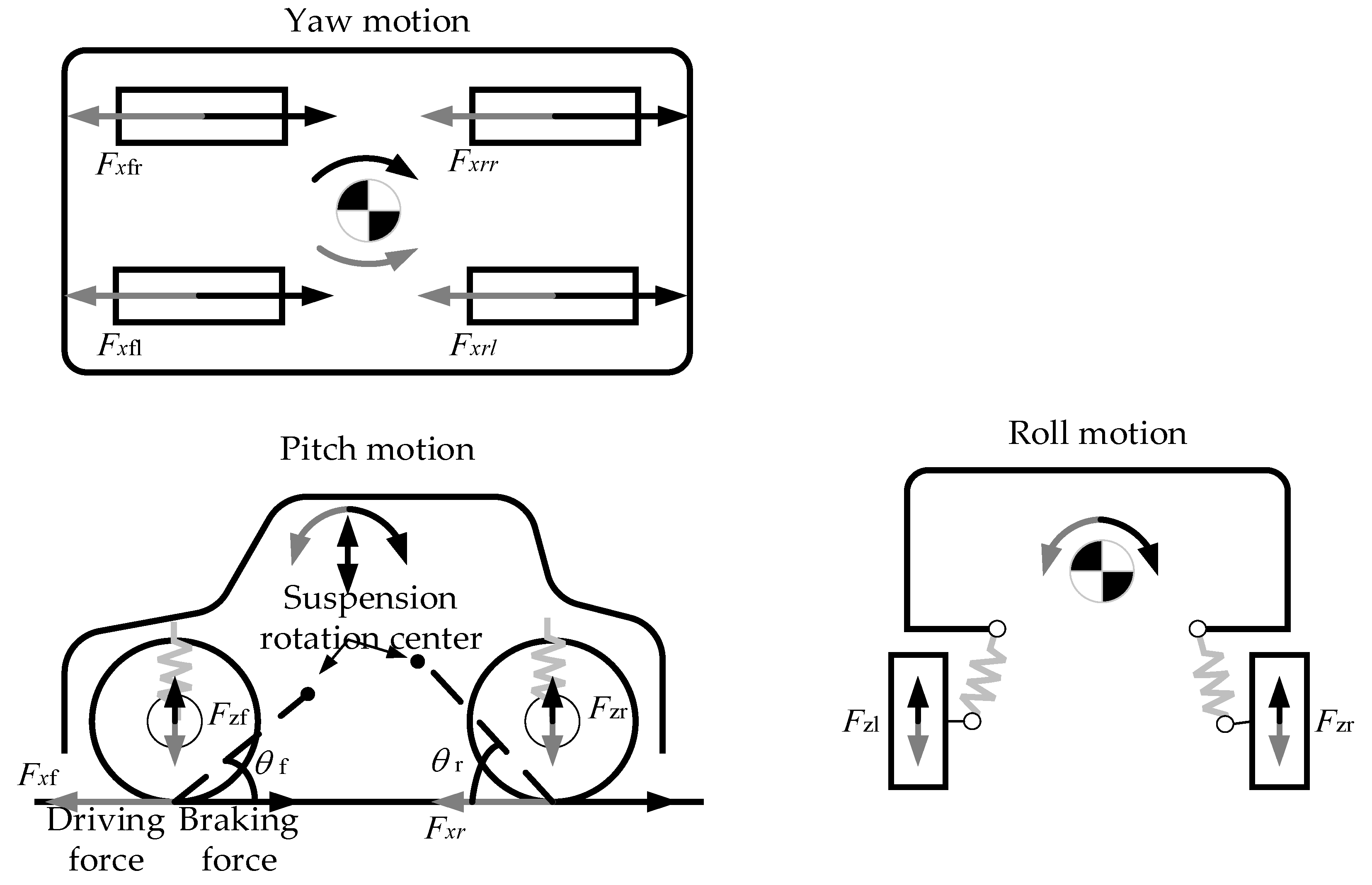

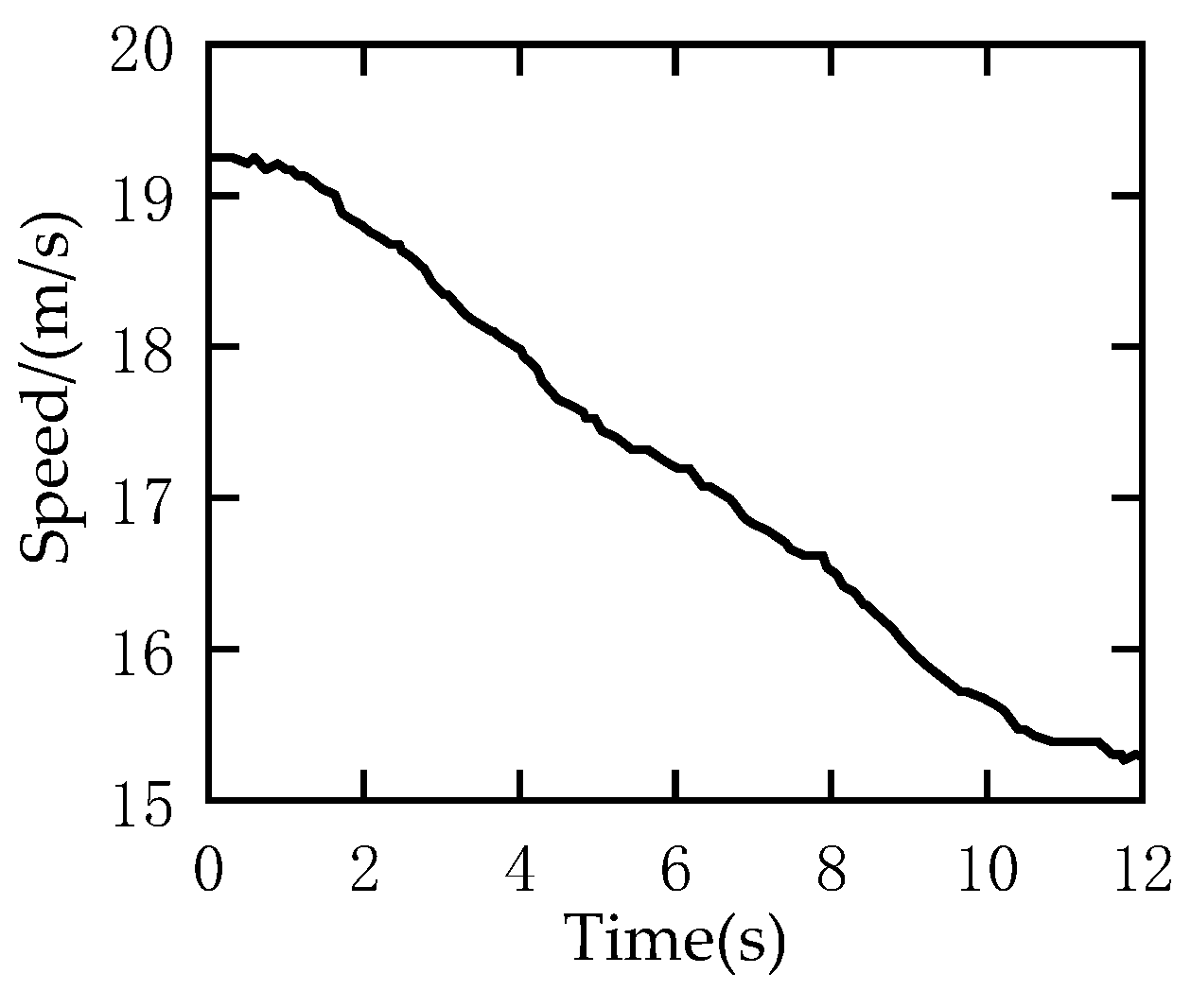



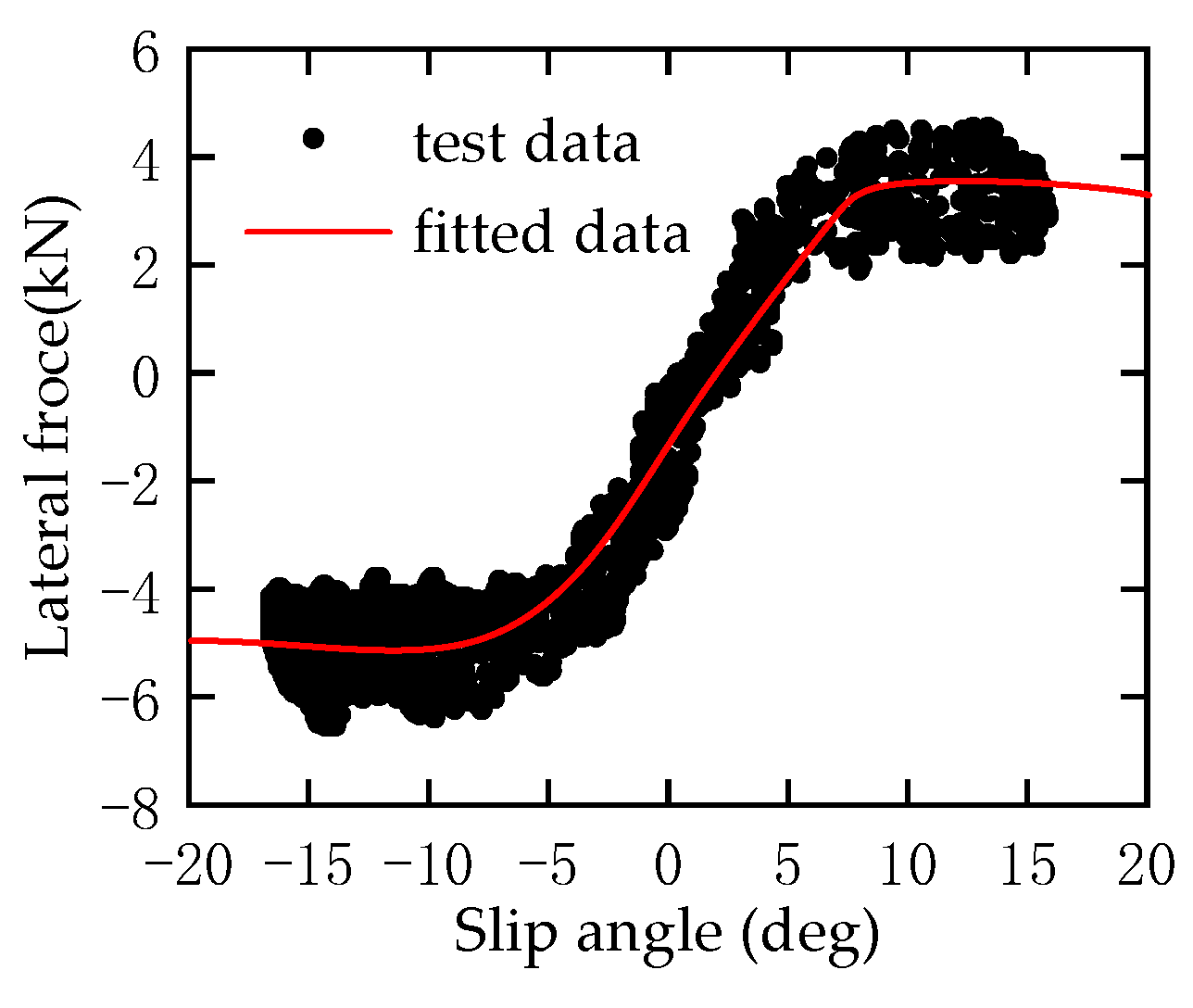
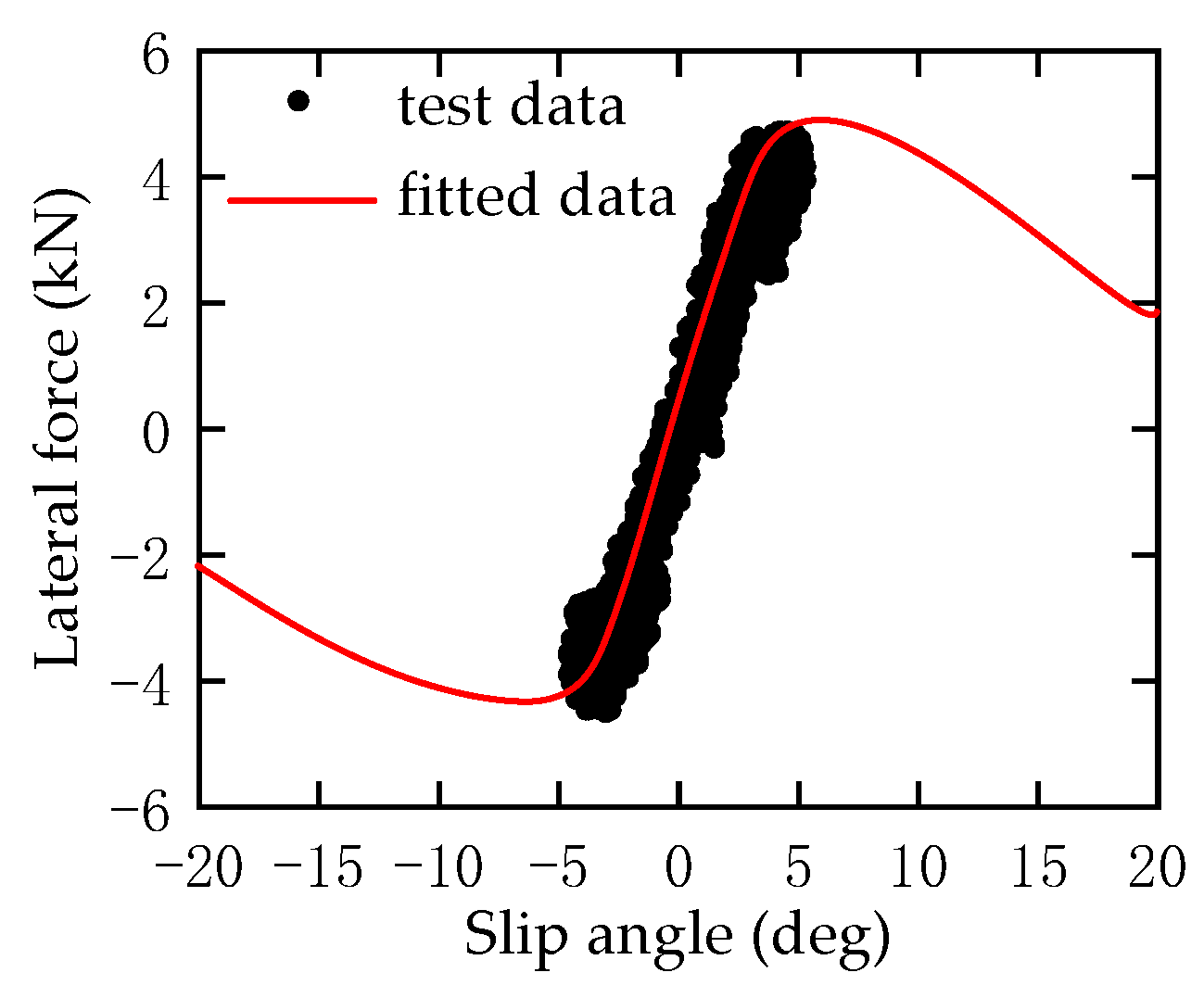

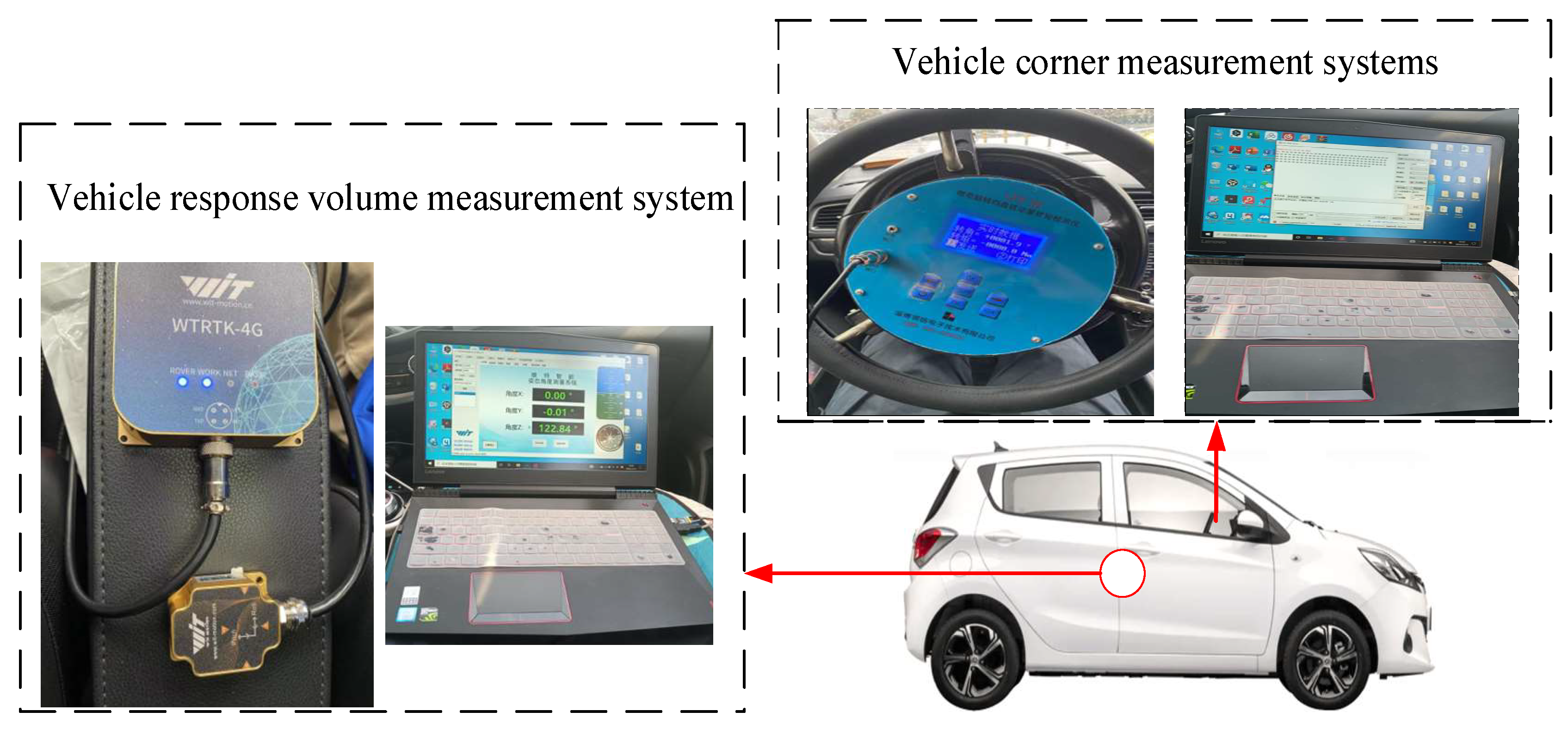
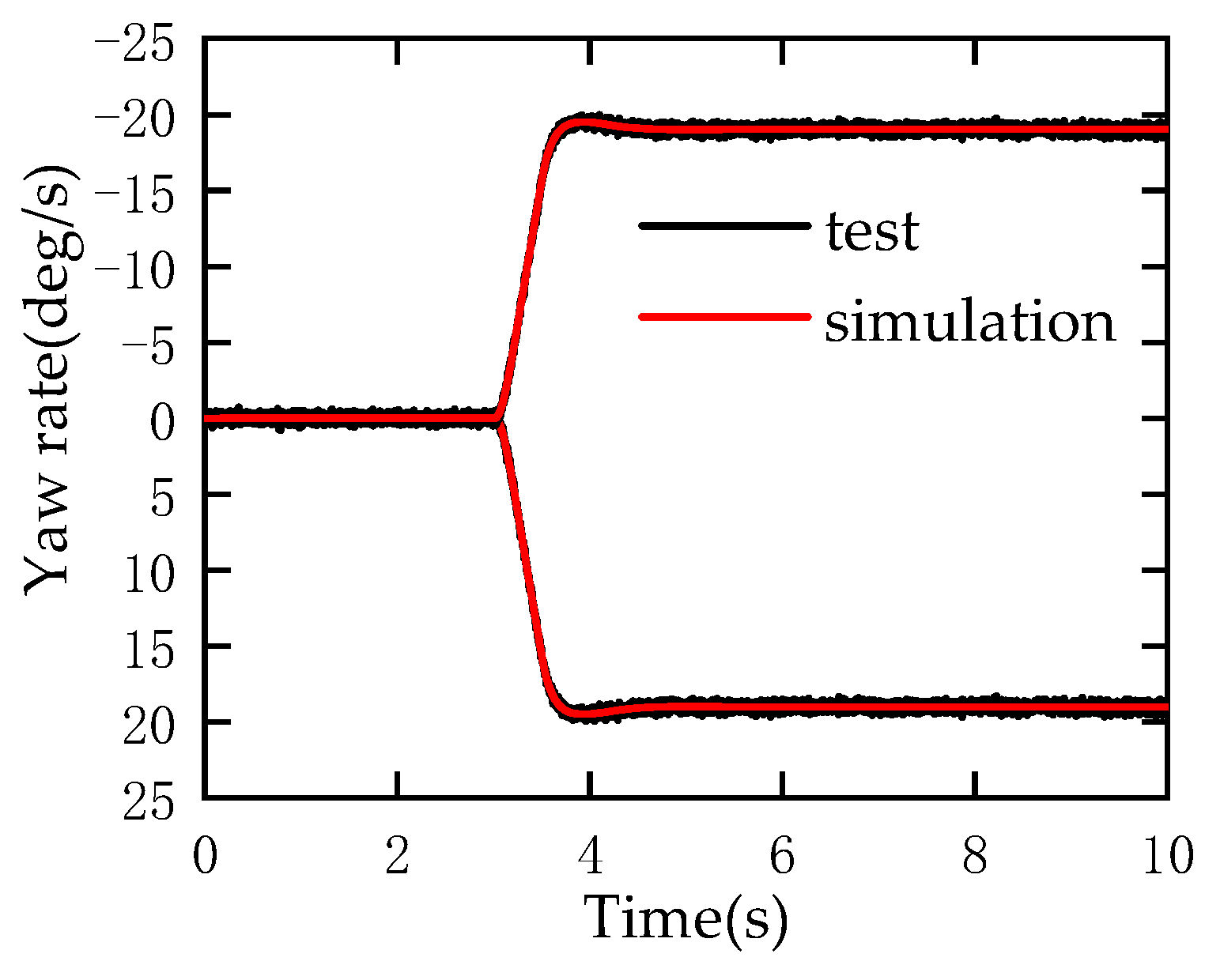
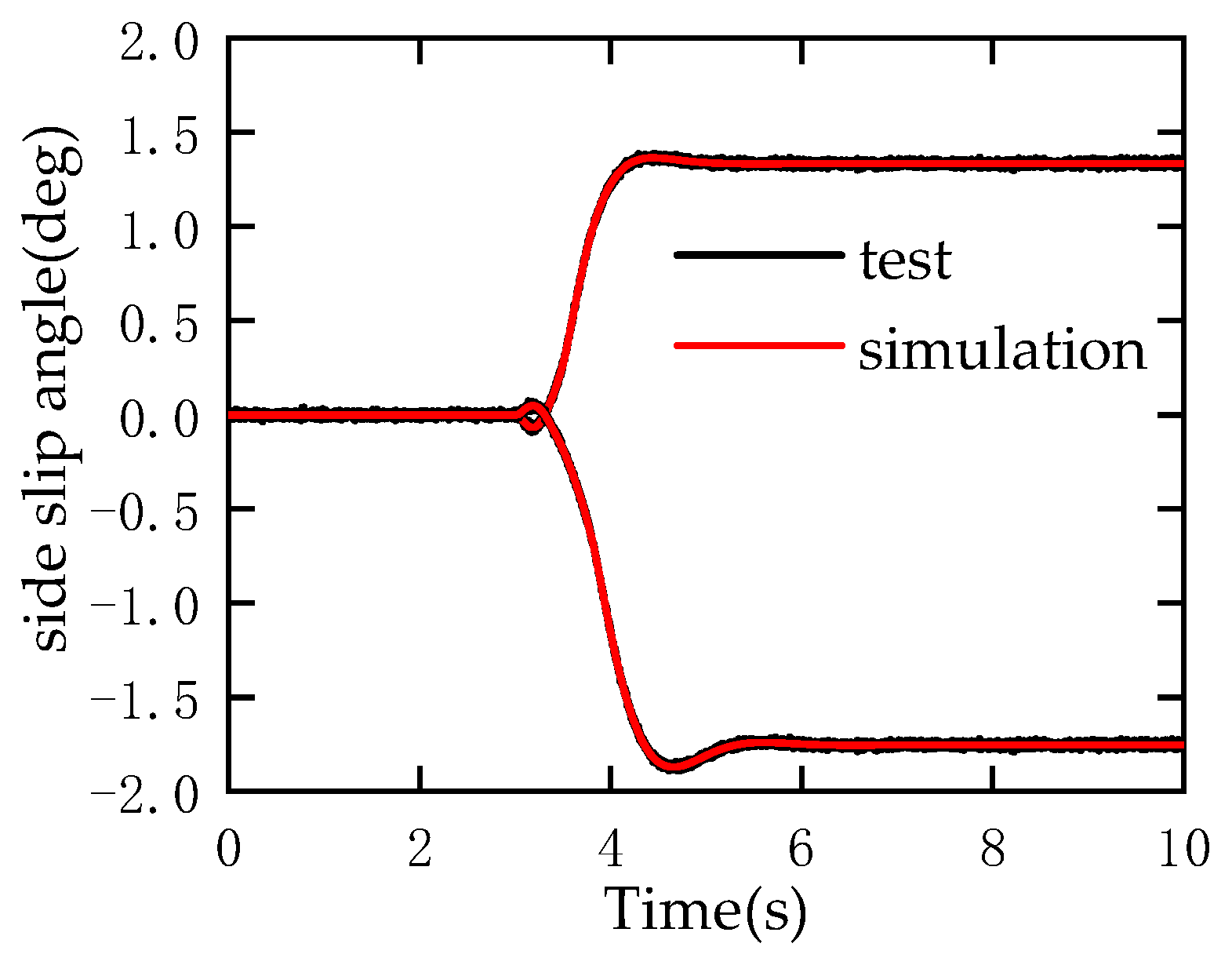
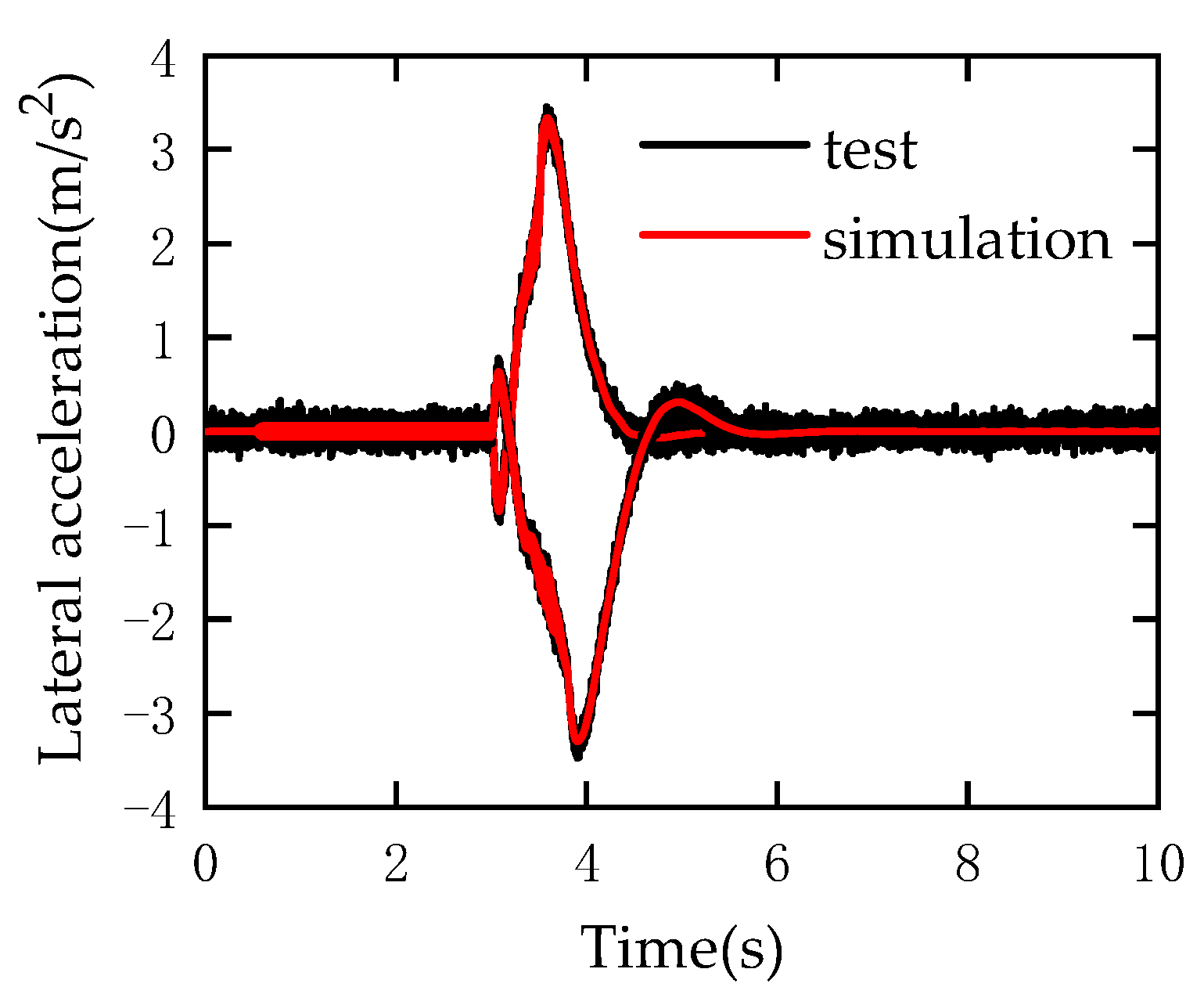


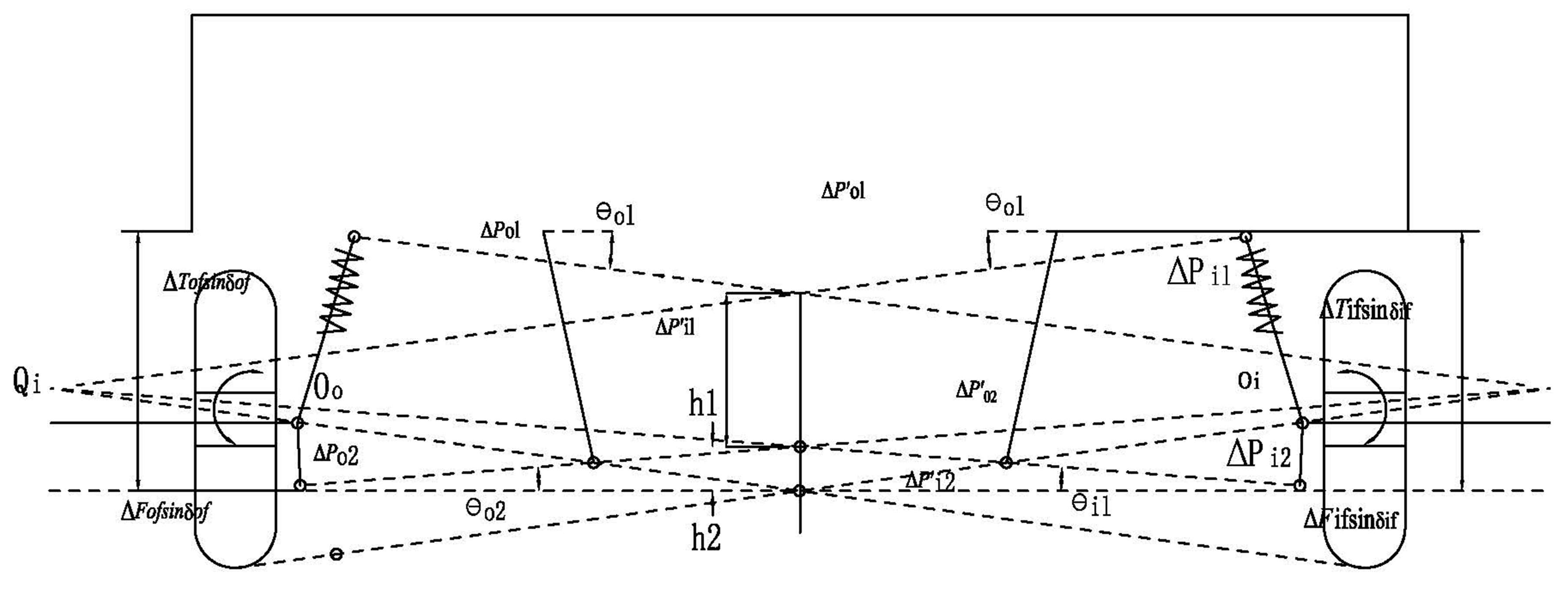
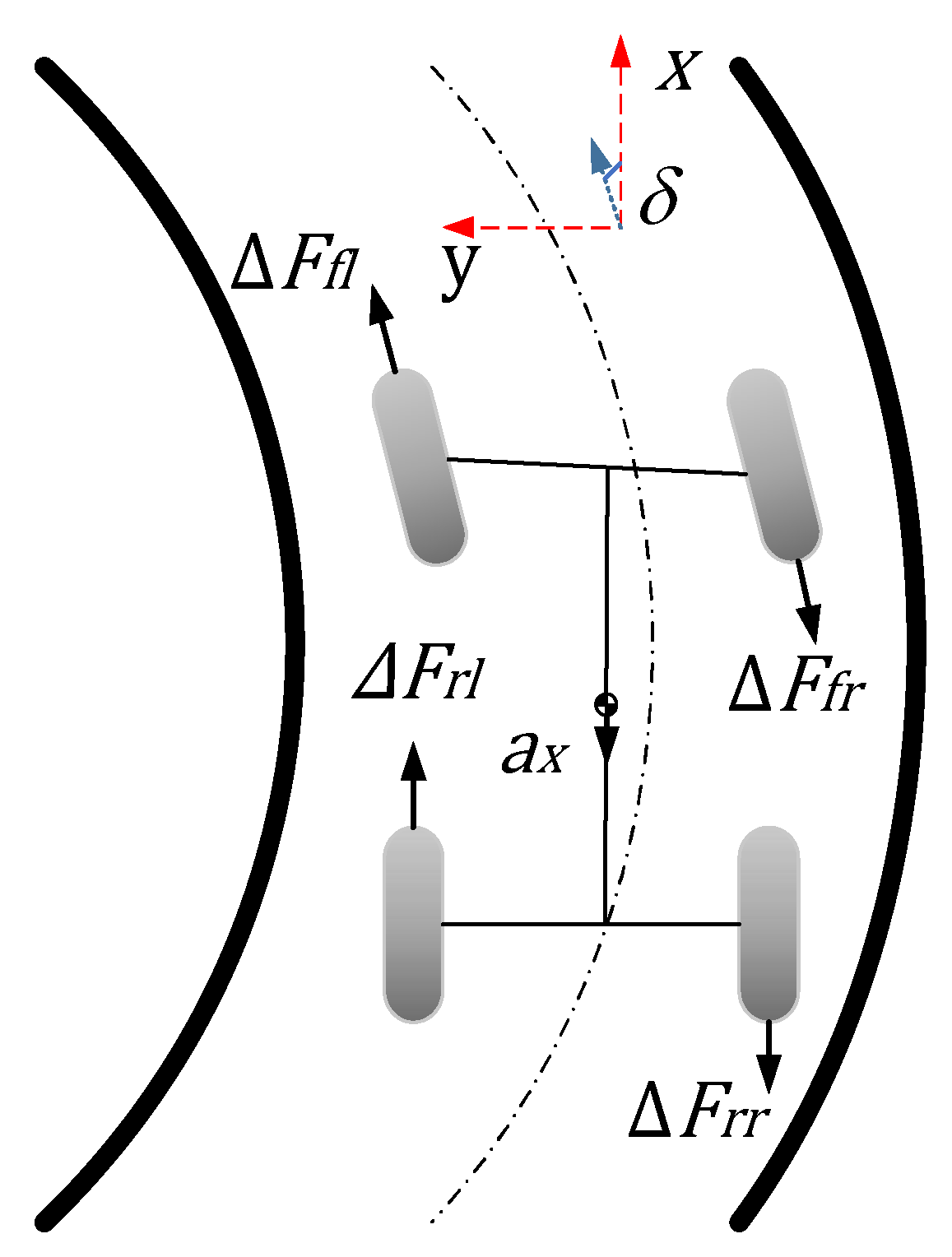
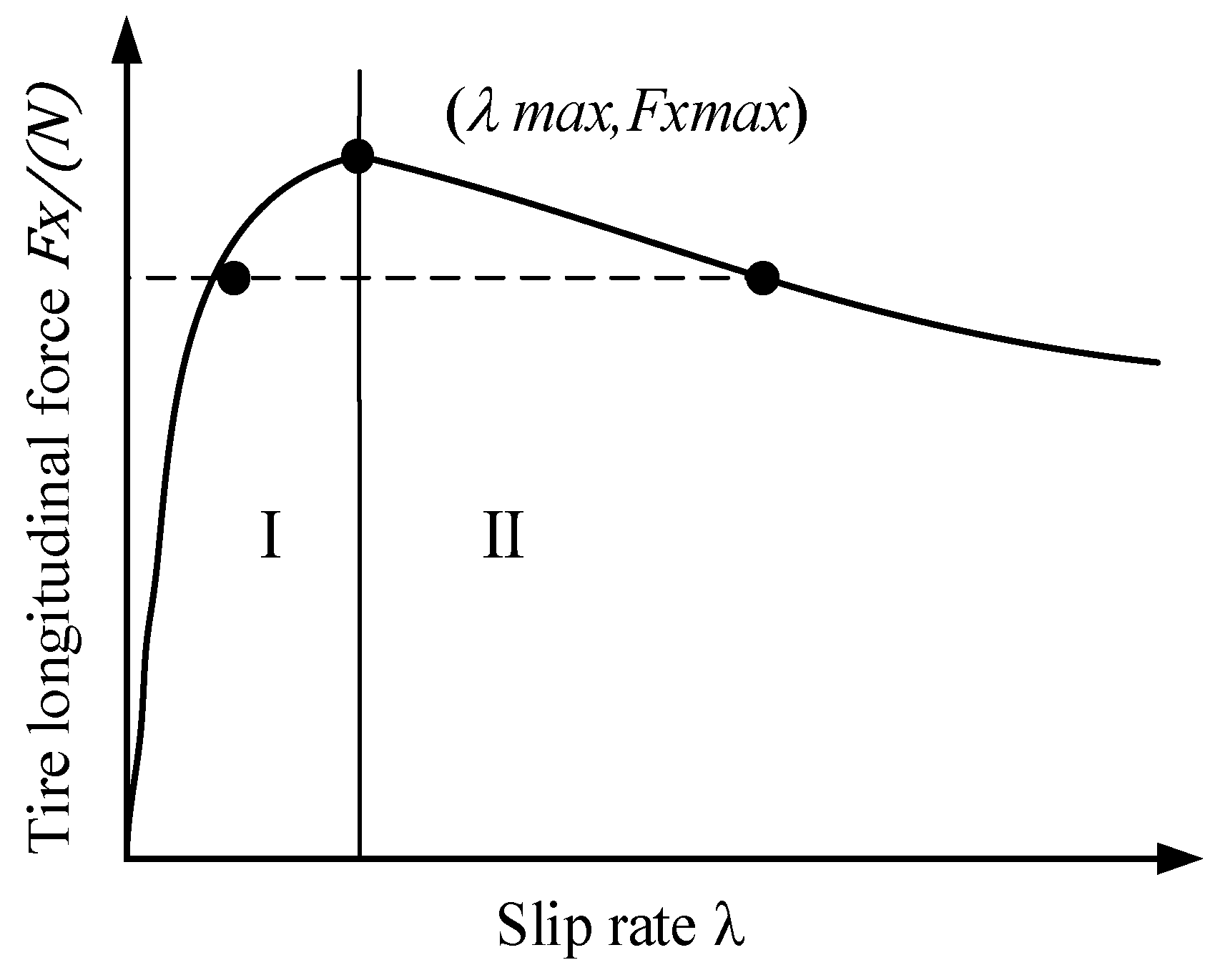
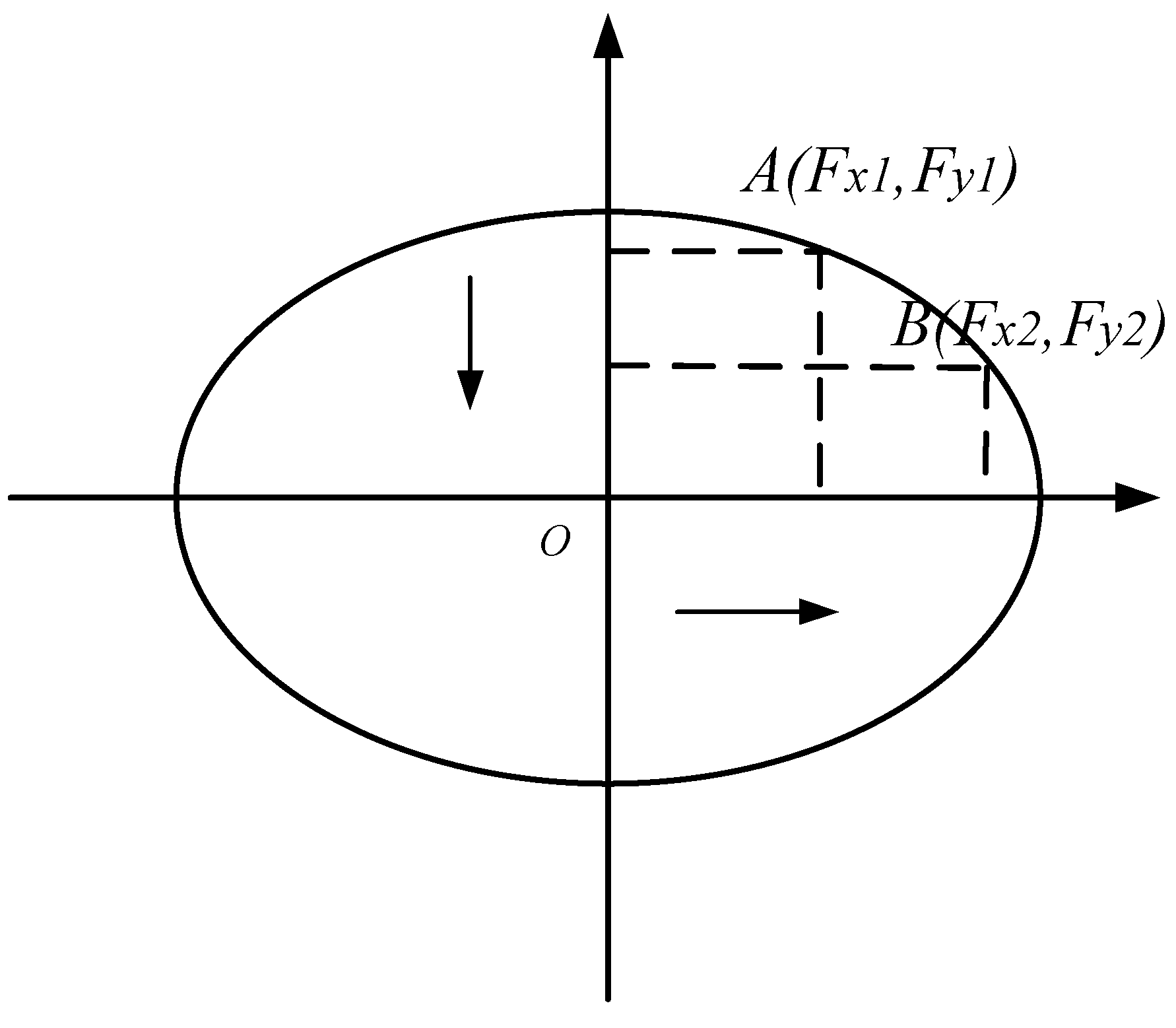
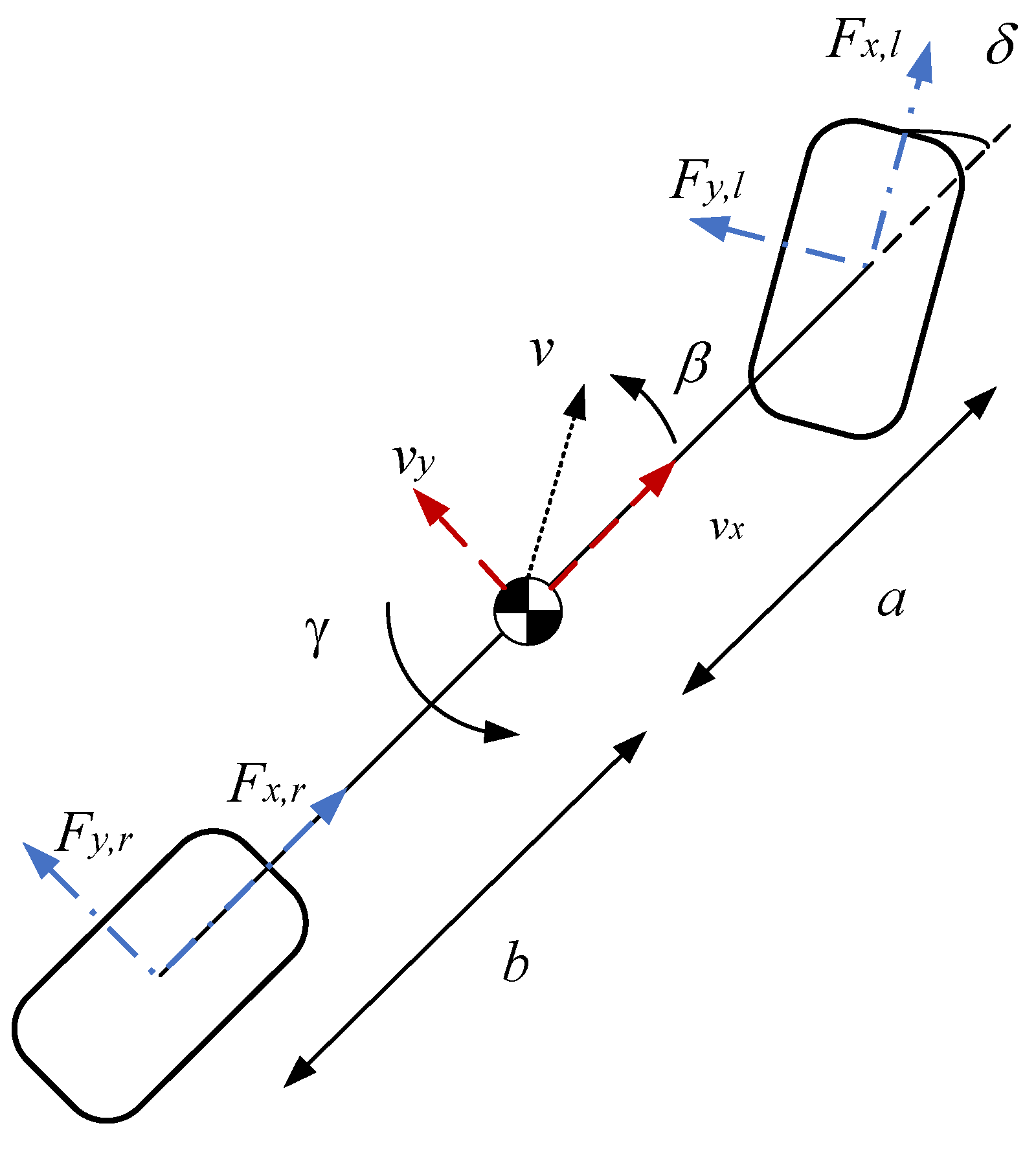
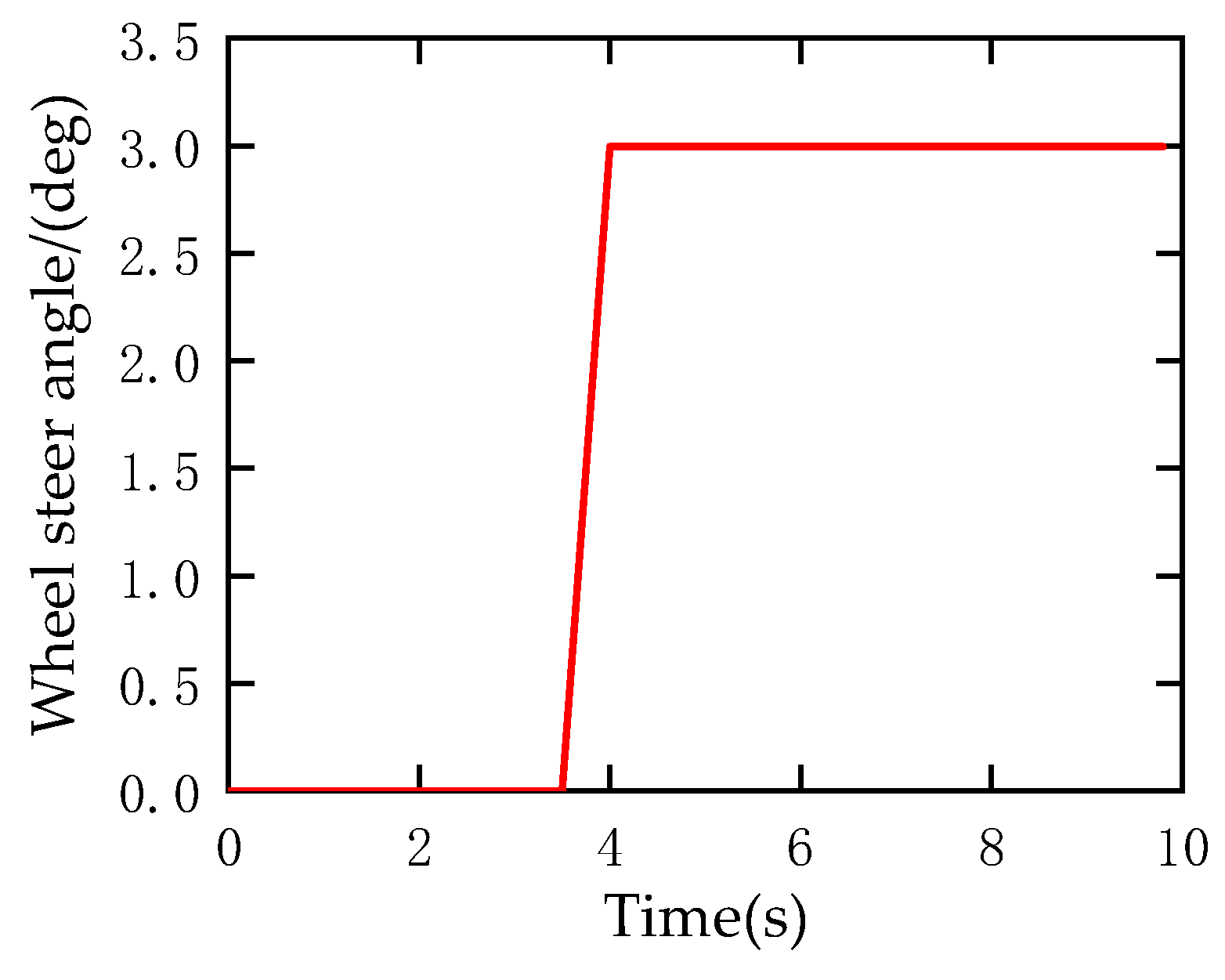

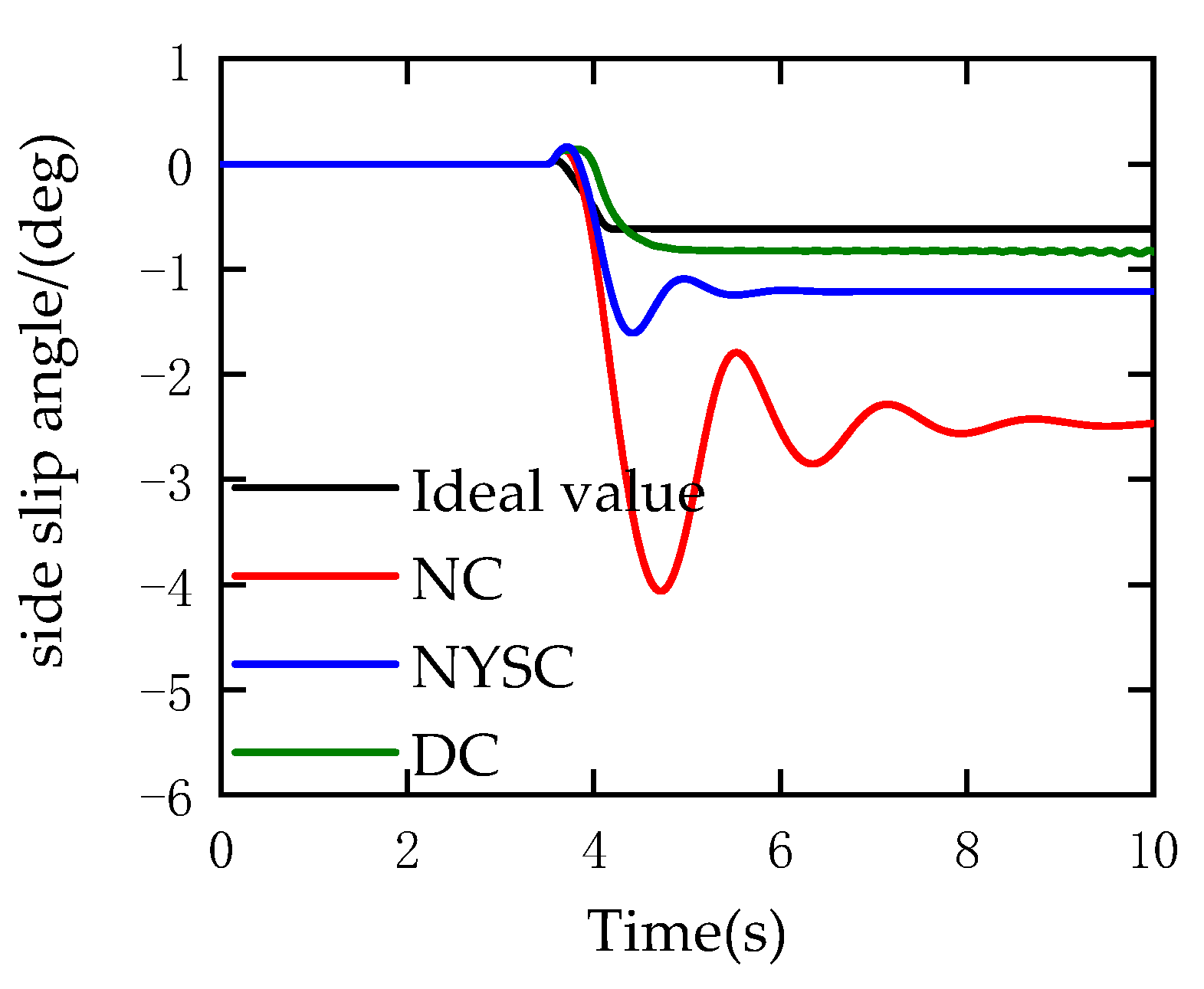


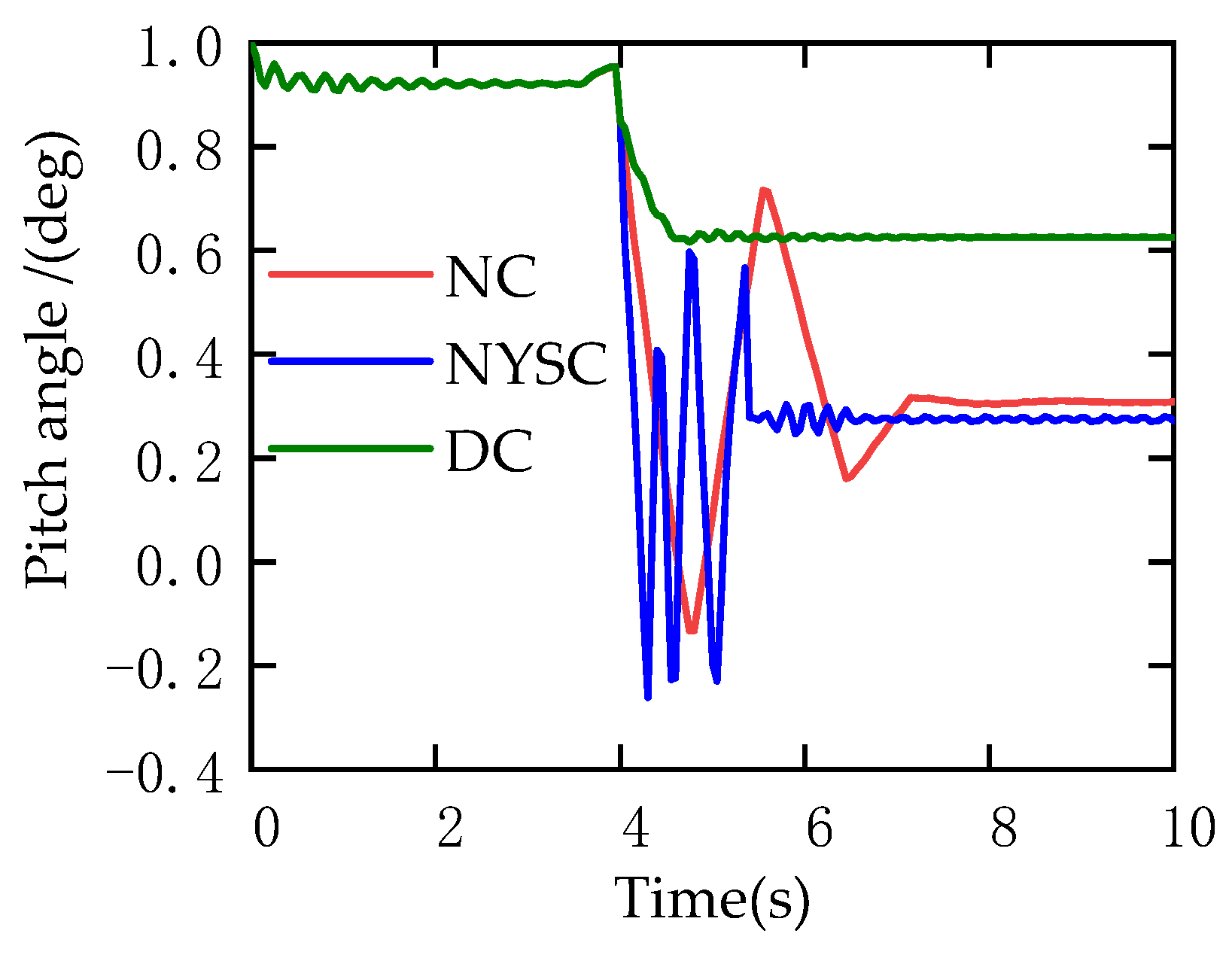
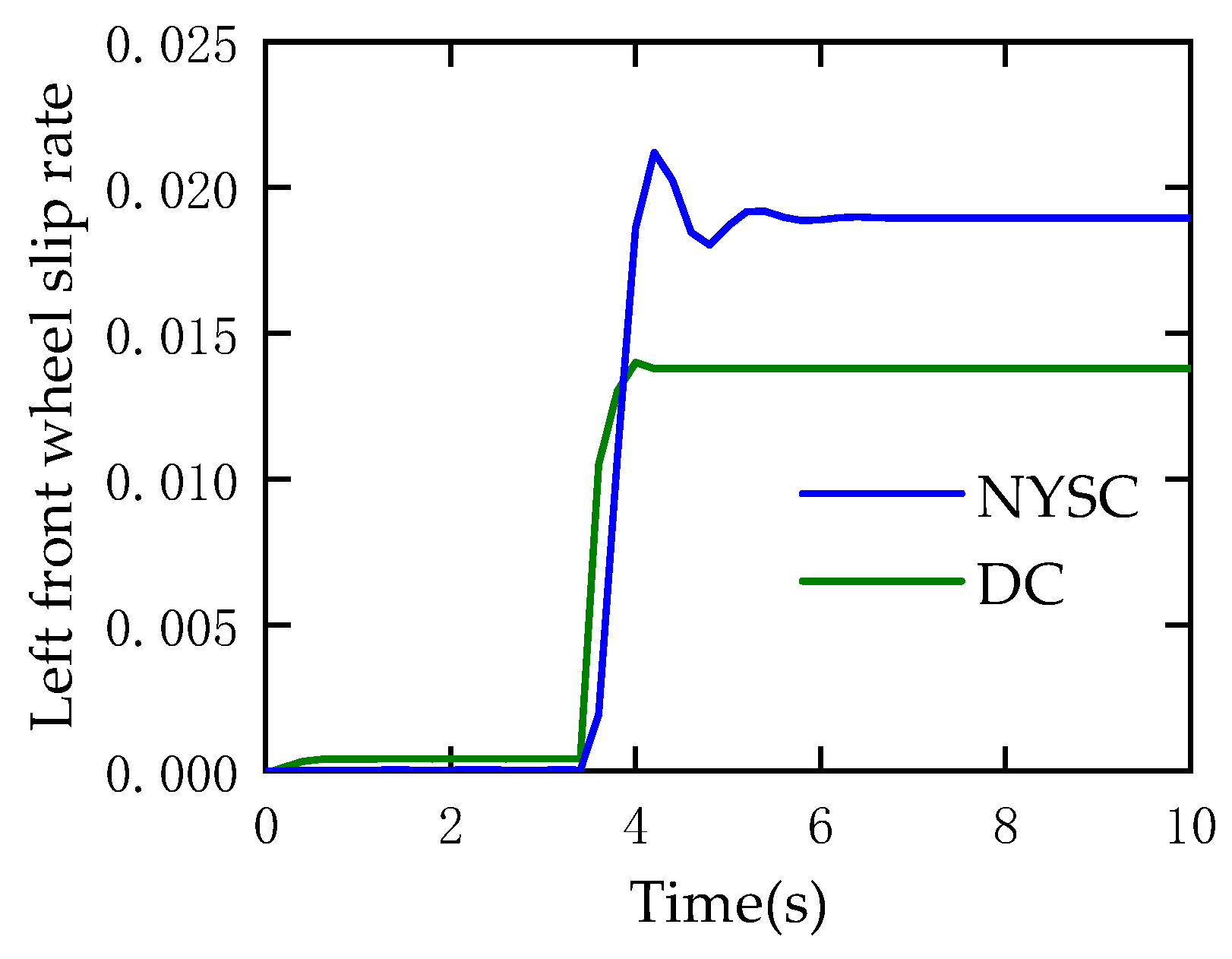

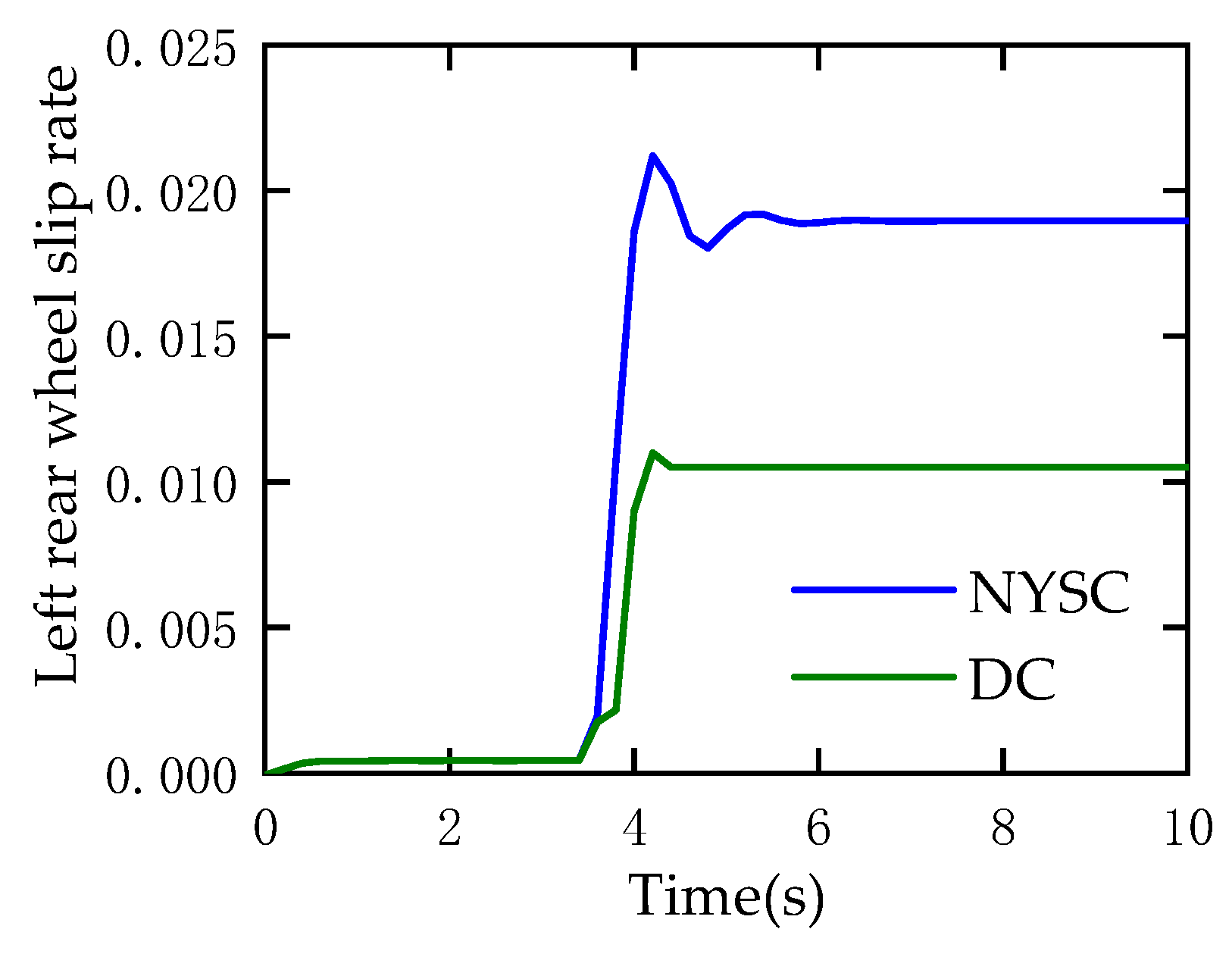
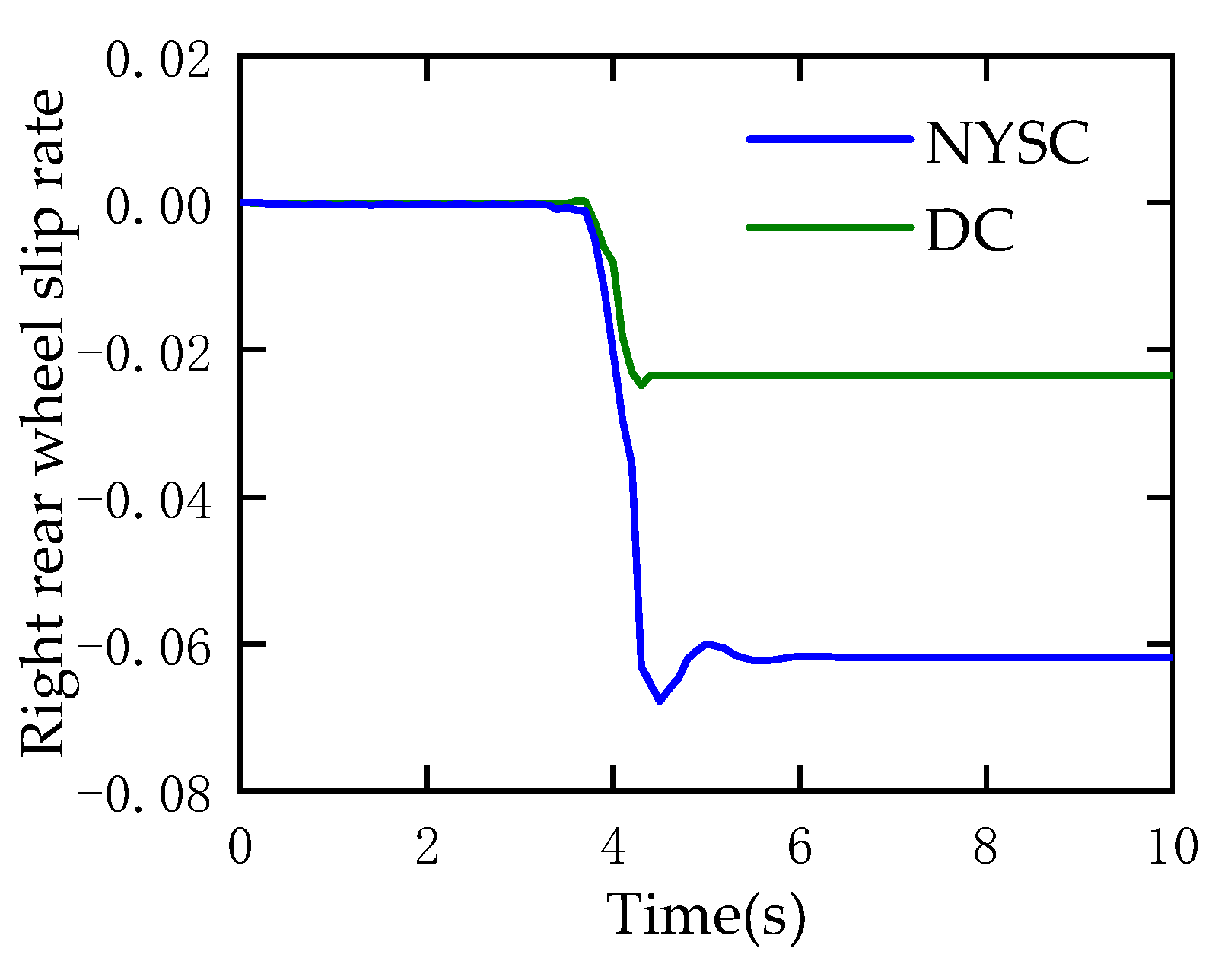
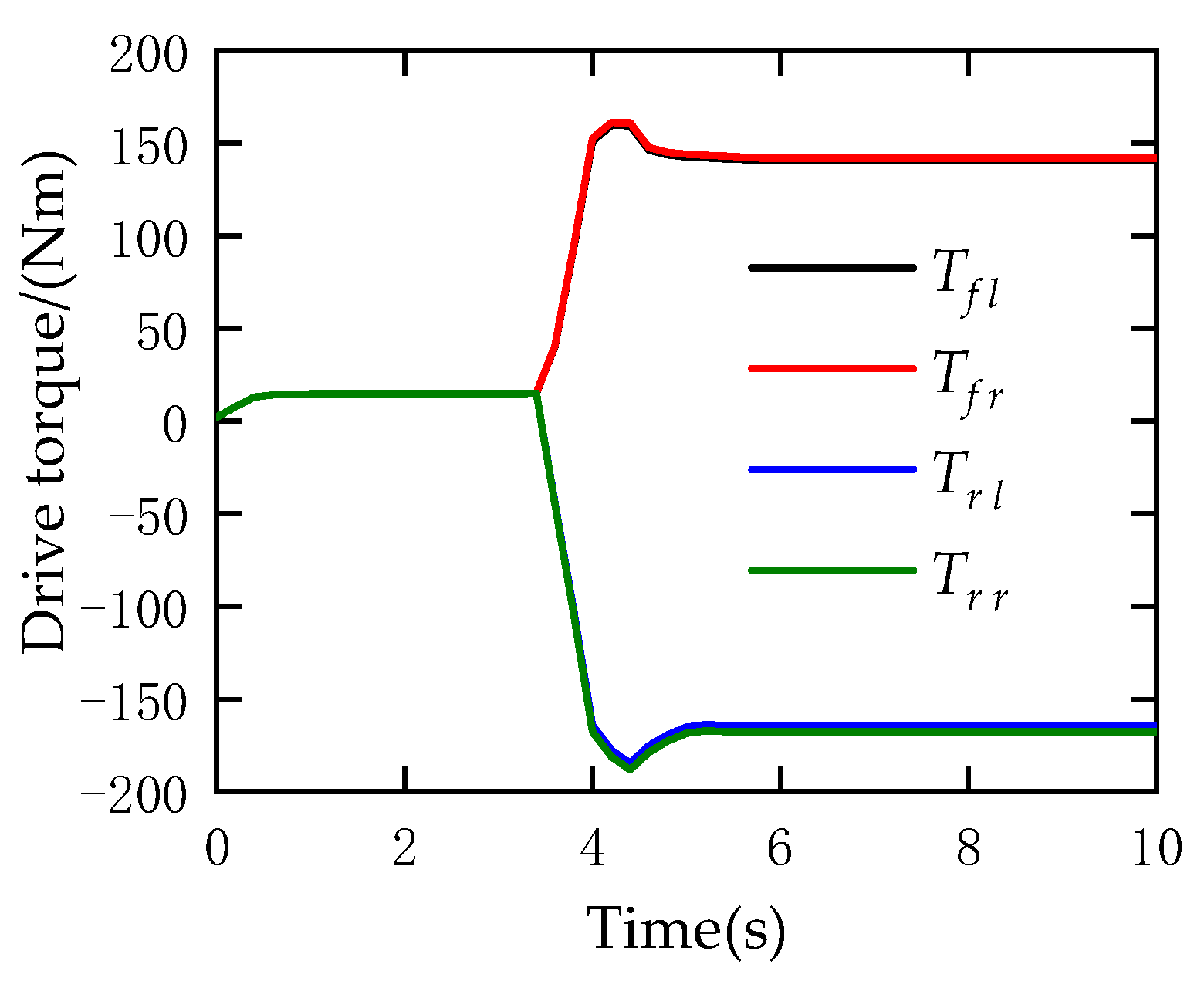
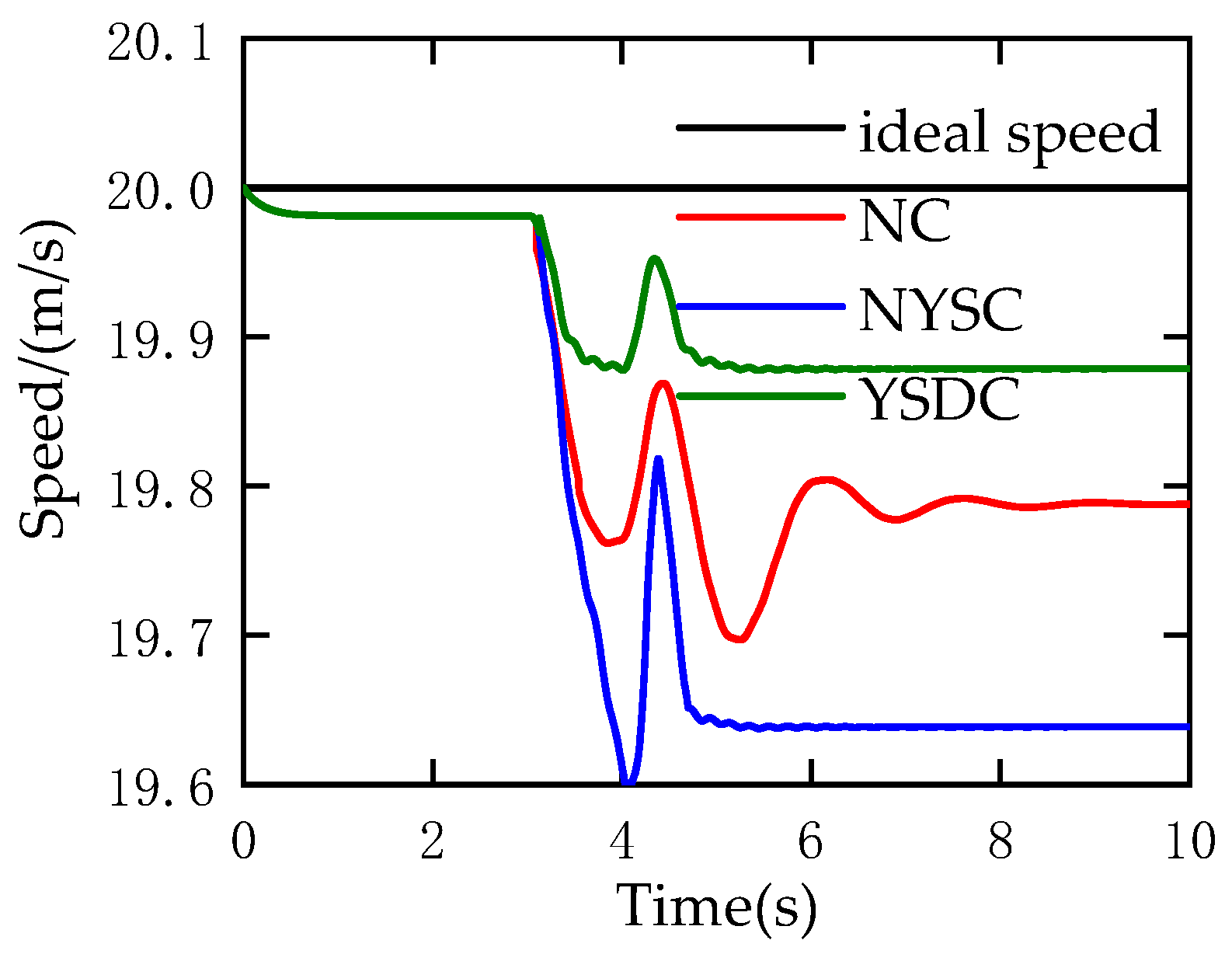




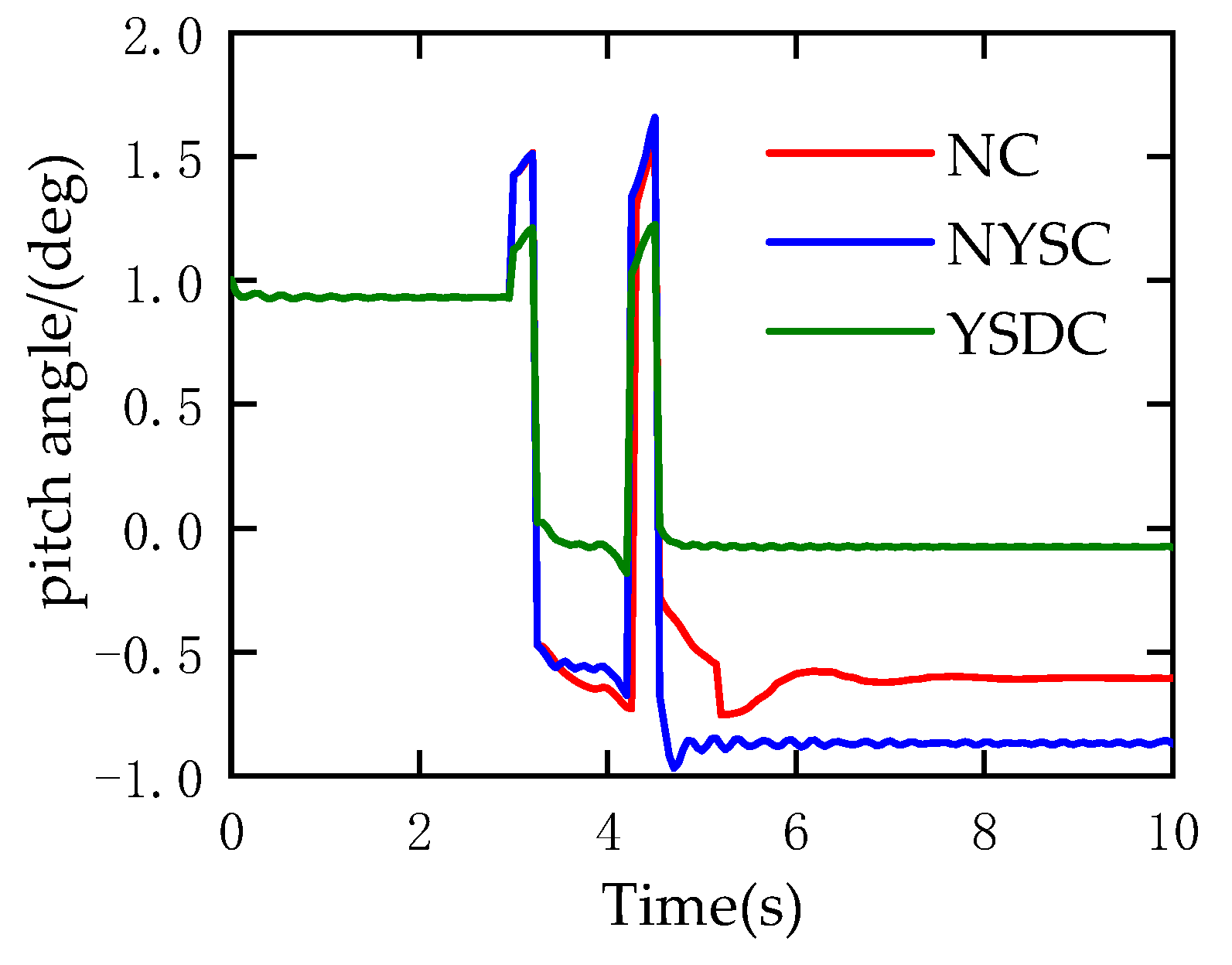
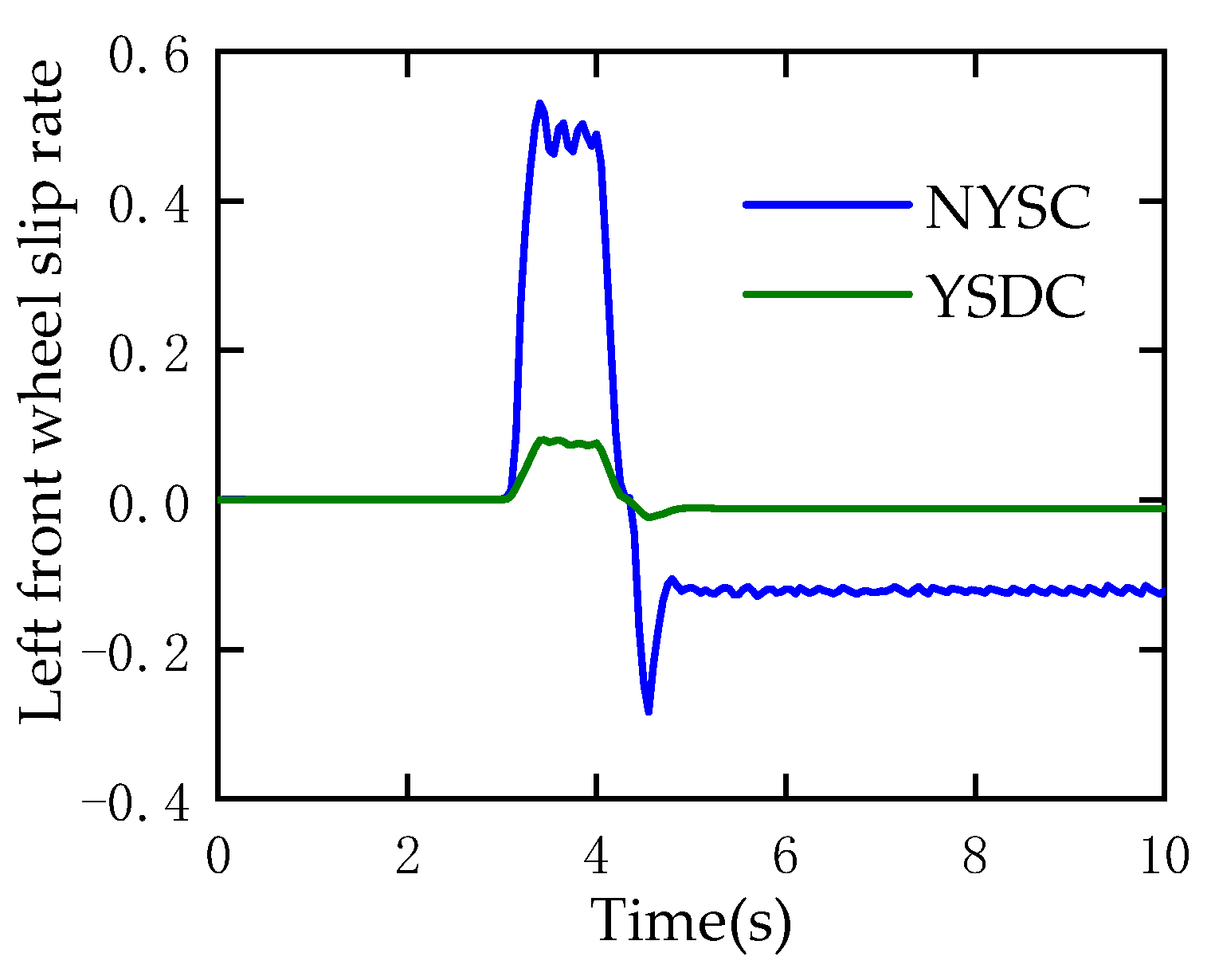

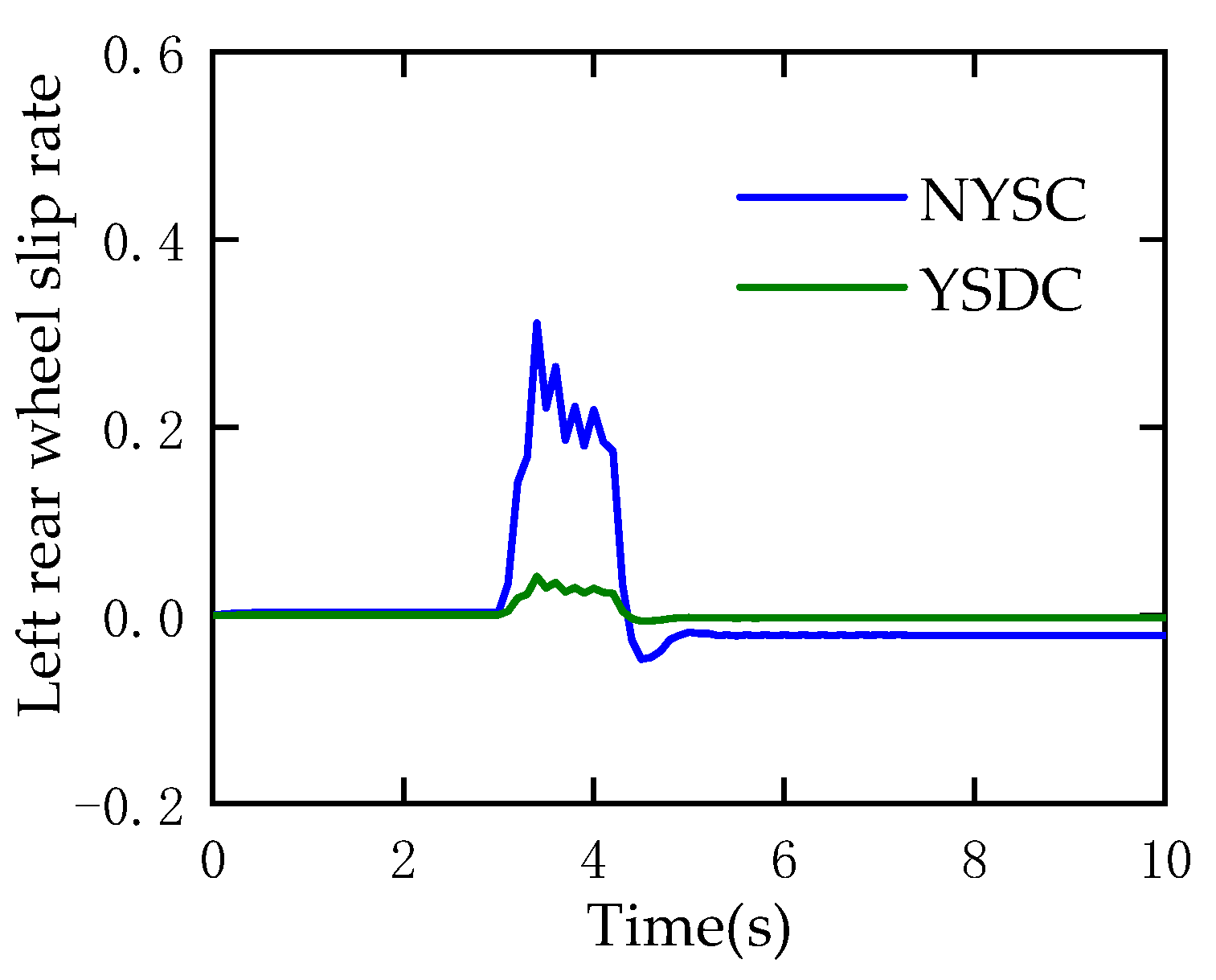
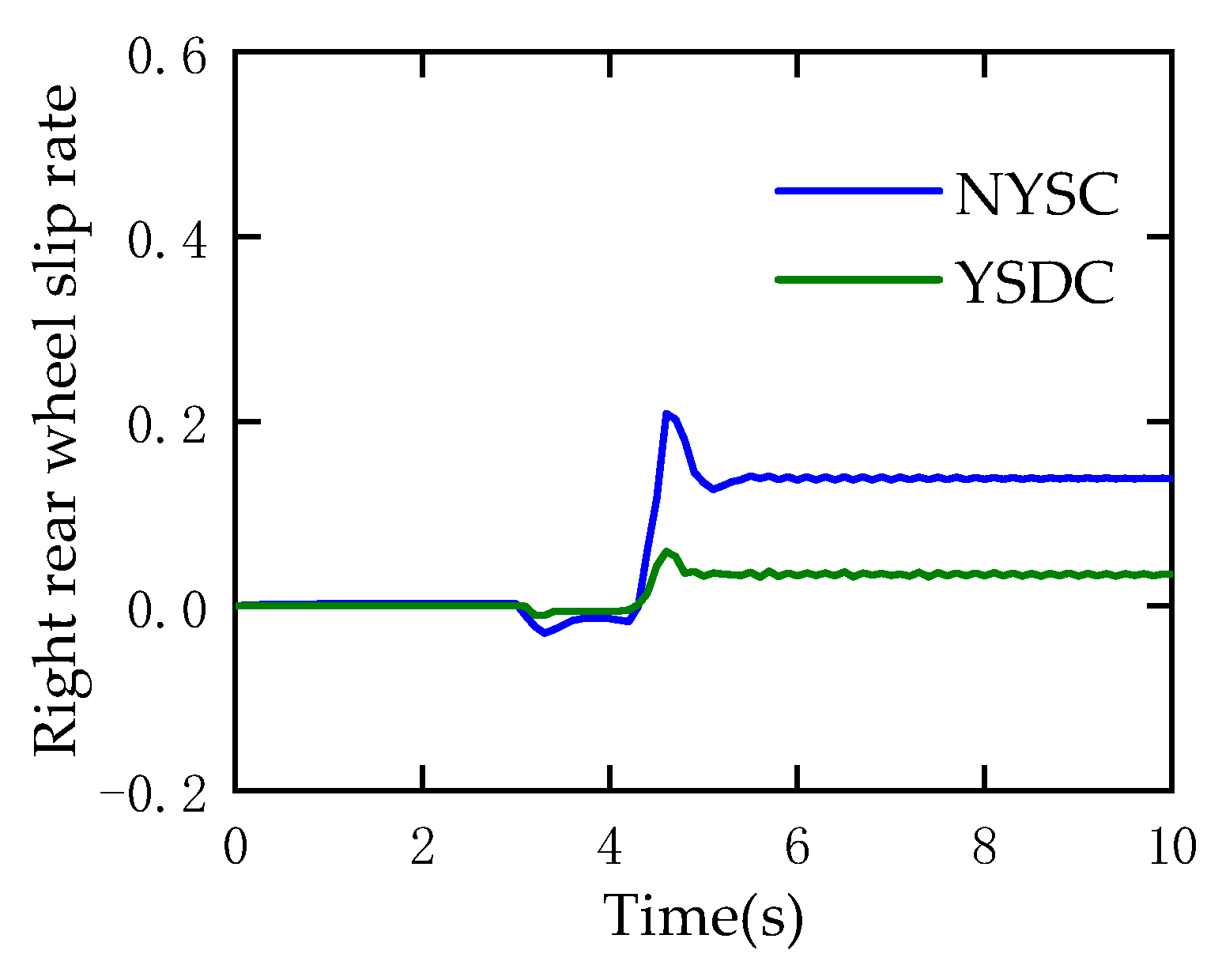

| Symbol | Physical Meaning | Unit |
|---|---|---|
| vehicle mass | kg | |
| Yaw rate | rad/s | |
| Distance from center of mass to front axis | m | |
| Distance from center of mass to rear axis | m | |
| Wheelbase | m | |
| Vehicle length | m | |
| Driver steering angle | deg | |
| Effective wheel radius | m | |
| Wheel longitudinal force | N | |
| Wheel Lateral force | N | |
| Tire-ground contact force | N | |
| Tread | m | |
| Wheel slip rate | / | |
| Vehicle side slip angle | deg | |
| Front-wheel lateral deflection stiffness | / | |
| Rear-wheel lateral deflection stiffness | / | |
| Longitudinal speed of the wheel | m/s | |
| Lateral speed of the wheel | m/s | |
| is front, is rear | / | |
| is left, is right | / | |
| Pavement adhesion coefficient | / |
| Serial Number | Test Conditions | Longitudinal Speed (m/s) | Longitudinal Acceleration (m/s2) |
|---|---|---|---|
| 1 | 8.3677 | −0.1161 | |
| 2 | 8.3392 | −0.1061 | |
| 3 | 8.2828 | −0.1674 | |
| 4 | 18.1849 | −0.4637 | |
| 5 | 18.1027 | −0.3791 | |
| 6 | 18.0616 | −0.3477 |
| Data Portfolio | ||
|---|---|---|
| 1,4 | −63.17 | −1.66 |
| 1,5 | −70.13 | −1.62 |
| 1,6 | −69.67 | −1.59 |
| 2,4 | −68.97 | −1.63 |
| 2,5 | −69.37 | −1.56 |
| 2,6 | −76.16 | −1.58 |
| 3,4 | −83.18 | −1.62 |
| 3,5 | −89.23 | −1.51 |
| 3,6 | −90.12 | −1.52 |
| Motor Parameters | Value | Unit |
|---|---|---|
| Rated power | 14 | kW |
| Peak power | 28 | kW |
| Rated rotation speed | 800 | |
| Peak rotation speed | 1600 | |
| Rated torque | 145 | |
| Peak torque | 290 |
Disclaimer/Publisher’s Note: The statements, opinions and data contained in all publications are solely those of the individual author(s) and contributor(s) and not of MDPI and/or the editor(s). MDPI and/or the editor(s) disclaim responsibility for any injury to people or property resulting from any ideas, methods, instructions or products referred to in the content. |
© 2024 by the authors. Licensee MDPI, Basel, Switzerland. This article is an open access article distributed under the terms and conditions of the Creative Commons Attribution (CC BY) license (https://creativecommons.org/licenses/by/4.0/).
Share and Cite
Wang, W.; Liu, Z.; Yang, S.; Song, X.; Qiu, Y.; Li, F. Decoupling Control of Yaw Stability of Distributed Drive Electric Vehicles. World Electr. Veh. J. 2024, 15, 65. https://doi.org/10.3390/wevj15020065
Wang W, Liu Z, Yang S, Song X, Qiu Y, Li F. Decoupling Control of Yaw Stability of Distributed Drive Electric Vehicles. World Electric Vehicle Journal. 2024; 15(2):65. https://doi.org/10.3390/wevj15020065
Chicago/Turabian StyleWang, Weijun, Zefeng Liu, Songlin Yang, Xiyan Song, Yuanyuan Qiu, and Fengjuan Li. 2024. "Decoupling Control of Yaw Stability of Distributed Drive Electric Vehicles" World Electric Vehicle Journal 15, no. 2: 65. https://doi.org/10.3390/wevj15020065





